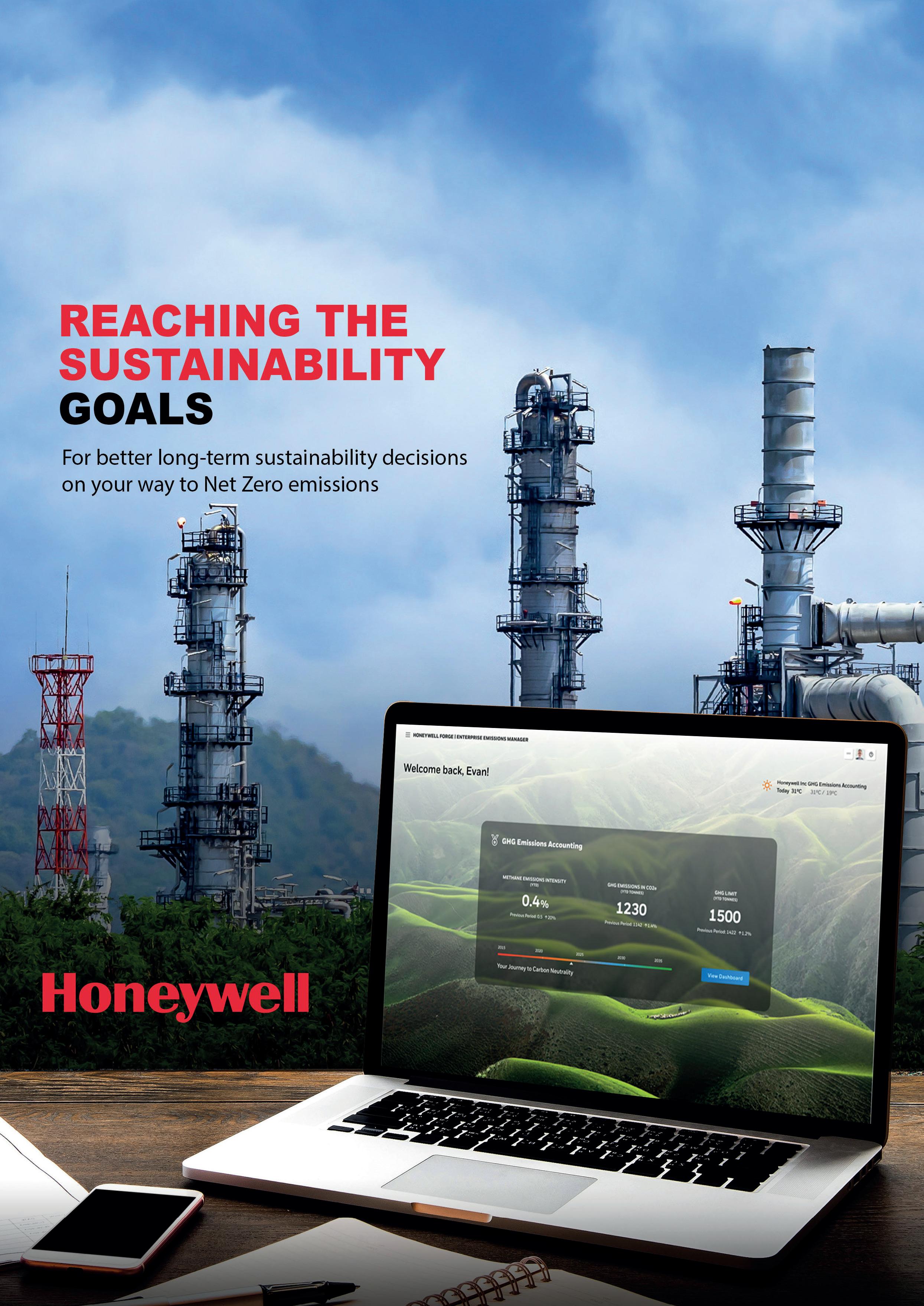






Drake Hernandez, Charles River Associates (CRA), USA, examines where demand for hydrogen may grow, and the implications of a potential shift to a liquid market.
Grant Grothen, Jane Newman-Ford and Randy Davis, Burns & McDonnell, USA, make a case for why hydrogen hubs will help shape the future of the global energy transition.
Hamburg, Germany, is driving the decarbonisation of industry and the establishment of a complete green hydrogen value chain. Matthias Beer, City of Hamburg, Germany, details the developments that are underway in the city and surrounding region.
Lennart van der Burg and Piet Warnaar, TNO, discuss the future of offshore hydrogen production: what to expect, whether we will be capable of producing our hydrogen offshore, and what the key benefits and challenges will be.
Robbie Gibson, Black & Veatch, UK, shares six core considerations to keep green hydrogen projects on track.
As public awareness of hydrogen’s potential as a clean alternative fuel grows, the improvement of electrolysers and increased availability of cost-competitive renewable energy will be essential to the green hydrogen industry’s growth.
James Abrams, American Bureau of Shipping (ABS), offers his

Ezio Pasqualon, Maire Tecnimont Group, alongside Stefano Andreola and Federico Freddi, NextChem, discuss the digital tools available to mitigate the intermittency challenges faced by the green hydrogen arena.
Bruno Roche, ABB, France, explains how leveraging digital capabilities can aid the scale-up of low-carbon hydrogen production to accelerate decarbonisation.
John Anderton, Atmos International, UK, discusses how pipeline simulation can assist with the hydrogen transition.
Ollie Burkinshaw, ROSEN UK, examines the extent to which the industry should aim to repurpose existing pipelines for hydrogen transport, as opposed to building new ones.
Manish Patel, Air Products, UK, outlines why there is massive potential for the UK to be at the heart of the international hydrogen economy.
As hydrogen fuel cell vehicles become more common, it is important to ensure that they – and the refuelling infrastructure to support them – operate safely and efficiently. Chuck Hayes, Swagelok Company, details how to choose the best fittings for hydrogen fuel cell technology.
Richard Laukam, ValvTechnologies; Tim Webb, Severn; and Mark Green, LB Bentley Ltd, discuss how equipment manufacturers are readying themselves to make a hydrogen-powered future a reality.
Tomoo Ishiguro and Ryoya Masumura, Riken Keiki, Japan, introduce a new method for determining the calorific value of hydrogen-blended gas.
In the future, Honeywell’s deployment of the Emissions Management SaaS will expand into more industries and applications to wherever greenhouse gas emissions are a concern.
Copyright© Palladian Publications Ltd 2022. All rights reserved. No part of this publication may be reproduced, stored in a retrieval system, or transmitted in any form or by any means, electronic, mechanical, photocopying, recording or otherwise, without the prior permission of the copyright owner. All views expressed in this journal are those of the respective contributors and are not necessarily the opinions of the publisher, neither do the publishers endorse any of the claims made in the articles or the advertisements. Printed in the UK.



H2scan’s proven sensing technology, based on R&D, engineering, and production excellence, is critical to the growth of a safe hydrogen economy.
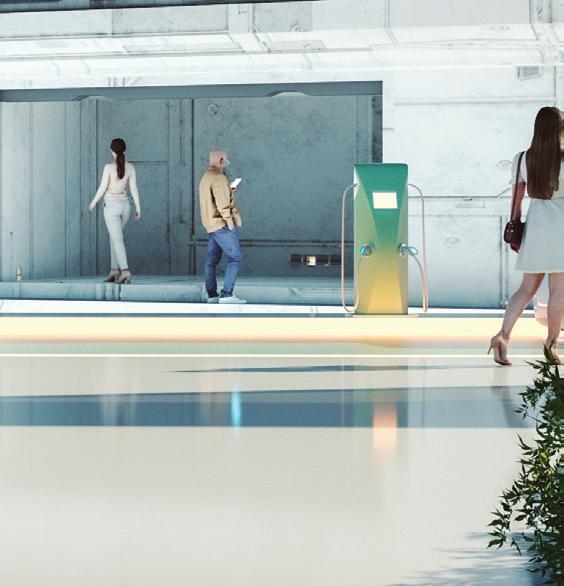







The
Find out more: www.h2scan.com


Managing Editor James Little james.little@palladianpublications.com
Senior Editor Callum O'Reilly callum.oreilly@palladianpublications.com
Assistant Editor Bella Weetch bella.weetch@palladianpublications.com
Editorial Assistant Isabelle Keltie isabelle.keltie@palladianpublications.com
Sales Director Rod Hardy rod.hardy@palladianpublications.com
Sales Manager Chris Atkin chris.atkin@palladianpublications.com

Sales Executive Sophie Birss sophie.birss@palladianpublications.com
Production Manager Kyla Waller kyla.waller@palladianpublications.com
Events Manager Louise Cameron louise.cameron@palladianpublications.com
Events Coordinator Stirling Viljoen stirling.viljoen@palladianpublications.com
Digital Content Assistant Merili Jurivete merili.jurivete@palladianpublications.com
Digital Administrator Leah Jones leah.jones@palladianpublications.com
Admin Manager Laura White laura.white@palladianpublications.com
As we all know, momentum in the hydrogen sector is gathering pace, with pilot and demonstration projects taking place the world over. Occasionally, these projects capture the attention of the mainstream media, and shine a bright light on hydrogen’s potential as a game changer for the energy transition.
One such project recently took place in the UK, where Rolls-Royce and easyJet conducted the world’s first successful test of a modern aircraft engine powered by hydrogen. The ground tests have been heralded by Rolls-Royce as a “major step towards proving that hydrogen could be a zero-carbon aviation fuel of the future.”
The test took place outdoors at a British military facility in Wiltshire using a Rolls-Royce AE-2100A gas turbine, a design used widely on regional airplanes around the world. Green hydrogen for the test was supplied by the European Marine Energy Centre, and was generated using renewable energy at the centre’s hydrogen production and tidal test facility on Eday, one of the Orkney Islands off the coast of Scotland.
The immediate aim of the project is to demonstrate that it is possible to run and control a jet engine using hydrogen fuel. So far, the tests have shown that the engine can be started up and run at low speed.
Of course, the long-term aim is for hydrogen to play a major role in decarbonising the aviation sector. David Morgan, easyJet’s Chief Operating Officer, believes that hydrogen is a “very exciting proposition” for the sector. He said: “We started a few years ago looking at what might power the aircraft of the future […] We looked at battery technology, and it was quite clear that the battery technology was probably not going to do it for the large commercial aircraft that we fly.”
Rolls-Royce’s customers, Airbus and Boeing, have also started taking initial steps into developing hydrogen technology. Airbus is using an A380 super-jumbo to test its first propulsion system using hydrogen, and hopes that a new passenger aircraft running on hydrogen could take to the skies by 2035. Boeing is testing hydrogen fuel cells on its ScanEagle3 military drone. Meanwhile, NASA recently announced that, with its support, university researchers have made advances towards developing hydrogen fuel cells and electricity-conducting technology to generate power for fully electric aircraft.
Of course, hydrogen aviation remains some way off for now, and will require significant research and investment. There are a number of hurdles to overcome in order to build a new engine that is capable of safely powering a commercial aircraft, and the aircrafts themselves will need to be redesigned to accommodate hydrogen storage. However, the building blocks for this nascent industry are starting to emerge, and there is every hope that the hydrogen aviation sector will now begin to take flight.
Editorial/advertisement offices: Palladian Publications 15 South Street, Farnham, Surrey GU9 7QU, UK Tel: +44 (0) 1252 718 999 www.globalhydrogenreview.com
On a separate note, I would like to say a big thank you to everyone who recently attended our inaugural Global Hydrogen Conference. The virtual conference was a resounding success, with attendees treated to fascinating presentations from our sponsors: PwC, Honeywell, H2scan, and Evides Industriewater. Everyone at Global Hydrogen Review really appreciates your support, and we look forward to continuing to deliver leading coverage of the hydrogen sector into 2023 and beyond.

For the past few years, much of the discourse in the hydrogen sector has been driven by colours. Green, blue, grey and pink, among many others, have set the tone for conversations regarding the future of hydrogen. As widely discussed, these colours refer to different production pathways for hydrogen. Grey hydrogen is hydrogen that has been produced via steam methane reforming (SMR) with no abated carbon dioxide (CO2) emissions; blue hydrogen uses the same production pathway, only with CO2 capture technology integrated into the process; and green hydrogen is hydrogen produced via an electrolyser that has been exclusively powered via renewable energy.
Unlike other energy commodities, conversations surrounding hydrogen started with a concerted focus on the carbon emissions associated with its production. Many alternatives to hydrogen exist, and the consumption of hydrogen may not be optimal for certain end uses –whether on an aggregate cost vs alternatives basis, or a ‘cost of reduced carbon’ basis.
The ‘cost of reduced carbon’ metric estimates how much it would cost to reduce a unit of CO2 emissions from an existing end use for each potential alternative to the commodity that is currently being used to meet that demand. These sorts of analyses are important when attempting to determine where hydrogen demand will materialise. While hydrogen, a molecule which does not emit CO2 when combusted, could technically be used throughout the energy and industrial sectors, it is not necessarily the optimal low-carbon alternative for all applications. Theoretically, hydrogen is best suited as an alternative for end uses that cannot be easily electrified, such as intercontinental shipping, or for which there is no clear substitute in an industrial process.

Approximately 90% of hydrogen currently used in the US is consumed as an industrial feedstock for the production of refined products or ammonia.1 At present, it is not consumed at large-scale as an energy vector. Currently, there is no alternative for hydrogen in its specific applications – primarily as a desulfurisation agent in the production of diesel, and as a key feedstock for ammonia production. Neither application explicitly uses hydrogen as an energy vector. In fact, hydrogen demand as an energy vector is driven largely by its consumption as a transportation fuel, but this consumption is marginal.
Nearly all hydrogen that is used as a transportation fuel in the US is consumed in California. As of 2Q21, roughly 4 tpd of hydrogen was dispensed to the transportation sector. Annualising this figure, one can estimate that the consumption of hydrogen within the transportation sector in California is approximately 1500 tpy.2 This represents roughly 0.01% of annual hydrogen consumption in the country (approximately 10 million t).
Demand for hydrogen as an industrial feedstock is generally met by the local supply of hydrogen installed onsite. In the refining context, a refinery could have an SMR installed onsite to produce the hydrogen needed for the customer’s industrial process. This SMR will also produce ancillary products, such as electric power and steam, that can be leveraged in the process and optimised around. In this context, the commercial terms in the contract must be asset-specific – the ‘delivered’ price that the customer pays for hydrogen is likely going to be a function of the operating characteristics of the SMR. For example, operating mode and local commodity, i.e. natural gas price.
Based on these commercial relationships, there is not a hydrogen market today that is similar to other energy commodities. Rather, the market consists of discrete buyers and sellers striking individual deals for the supply of hydrogen that is directly tied to specific assets. This is in contrast to commodities such as natural gas, oil or electric power, where market prices exist.
Drake Hernandez, Charles River Associates (CRA), USA, examines where demand for hydrogen may grow, and the implications of a potential shift to a liquid market.
As demand for hydrogen grows beyond these existing demand centres, the landscape of buyers and sellers of hydrogen will likely become more diverse. The US, for example, has recently acted to stimulate the development of a hydrogen market through the passing of a specific policy aimed at growing demand for clean hydrogen within current end uses and in new industries which have not historically consumed hydrogen. These policy measures include funding for hydrogen hubs and a production tax credit for clean hydrogen production. The Infrastructure Investment and Jobs Act (IIJA), passed in November 2021, specifically allocated US$8 billion for the development of hydrogen hubs throughout the US. These hydrogen hubs are meant to enable the development of a diversity of energy supply sources and demand sinks for clean hydrogen.
For example, the law specifically states: (i) “at least one regional clean hydrogen hub shall demonstrate the production of clean hydrogen from nuclear energy”, and (ii) “at least one regional clean hydrogen hub shall demonstrate the end use of clean hydrogen in the electric power generation sector.”3 Additionally, the law calls for at least two of these clean hydrogen hubs to be developed in regions with the greatest natural gas resources.
The Inflation Reduction Act of 2022, which was signed into law in August 2022, included provisions for a clean hydrogen production tax credit. This tax credit is tiered, based on the total CO2 emissions associated with the production of hydrogen. If the life cycle emissions of the produced hydrogen are less than 0.45 kg of CO2 for each kg of hydrogen produced, the supplier would qualify for a US$3/kg production tax credit. This tax credit can be used to decrease the delivered cost of clean hydrogen to customers, while ensuring that the supplier earns an adequate return on the investment that they have made in the clean hydrogen production asset.
These federal efforts could drive significant change in the supply and demand balance for hydrogen that may accelerate market development, especially as hydrogen demand grows outside of traditional industrial sectors. However, market development does not occur without project development.
It is possible that as new, incremental demand for hydrogen grows in regions in which it has not been consumed historically, local supply will be developed to meet this demand. To minimise the risk associated with developing new supply-side projects, developers will likely look to ensure that they have adequate offtake in place to justify making a final investment decision (FID) on the project. This offtake could be codified as a contract with a customer which clearly lays out the commercial terms – including the pricing mechanism and term – and could look similar to those seen in the industrial sector, whereby contracts are asset-specific, bilateral agreements between the buyer and seller. This contractual structure would ensure that risk is adequately shared between the supplier and offtaker given the very early stage of the market.
In the medium-to-long term, as demand for hydrogen grows across various sectors, and the initial contracts that are struck to develop supply expire, the commercial relationship between buyer and seller could materially shift from a bilateral contracting mechanism towards a pricing mechanism that is seen in other energy commodity markets.
This future could imply that a liquid market for hydrogen exists, and that a buyer could simply go to the market to secure the adequate quantity of hydrogen for their demand. In such a market, suppliers would look to compete to produce the lowest variable cost hydrogen to ensure that their supply is ‘lower’ in the supply stack – increasing the probability that their supply would clear the market and ultimately be sold to customers. In this future, the default assumption that hydrogen supply is co-located with demand would not necessarily hold.
As suppliers look to produce the most cost-effective hydrogen, they may site their projects in more remote regions with more favourable resources for the production of hydrogen. As these supply regions develop, it is possible that the amount of hydrogen produced in these remote regions would justify investment in a large-scale hydrogen transmission asset – such as a pipeline – to cost-effectively move hydrogen to regions of high demand. This sort of midstream infrastructure has developed organically, and by necessity, in other energy commodity markets due to the fact that the resource (such as oil or natural gas) is geologically-located in specific locations, whilst demand for the commodity remains ubiquitous.
Although, in theory, hydrogen can be produced anywhere so long as the location has adequate access to electric power and water in the context of electrolysis, or natural gas and CO2 sequestration pore space in the context of SMR as suppliers look to compete to produce the lowest cost hydrogen to satisfy demand within the region, it will be critical that the supplier has access to the lowest cost feedstock to produce hydrogen. This may not necessarily be directly co-located with the demand centre.
The hydrogen market is developing, aided by recent policy measures passed by the US Congress. However, the future of this market is unclear. Demand for hydrogen will likely increase, but it is not obvious where this demand will grow, nor which industries in particular will witness significant growth and investment. The long-term resultant market structure will ultimately depend on how and where this demand appears. This topic is nuanced and complex. While understanding the environmental impact of the development of this market is critical, the discussion surrounding the colours of hydrogen is only an entry point to a broader discussion about the economics of hydrogen and associated market development within the sector.
1. ‘Hydrogen Program Plan’, US Department of Energy, (2020), https:// www.hydrogen.energy.gov/pdfs/hydrogen-program-plan-2020.pdf
2. ‘Joint Agency Staff Report on Assembly Bill 8: 2021 Annual Assessment of Time and Cost Needed to Attain 100 Hydrogen Refueling Stations in California’, California Energy Commission, https://www.energy.ca.gov/sites/default/files/2021-12/CEC-6002021-040.pdf, p. 16.
3. ‘Infrastructure Investment and Jobs Act’, https://www.congress. gov/117/plaws/publ58/PLAW-117publ58.pdf, p. 581.

The momentum behind hydrogen hub development is truly global. In July 2022, the European Commission approved a large hydrogen hub initiative, the Hy2Tech, which is a programme that promises up to US$5.5 billion in public funding from 15 EU member states. Canada recently signed a declaration of intent with Germany for the establishment of a trans-Atlantic hydrogen supply corridor, with plans to begin exporting low-carbon hydrogen (with production powered by Canadian wind generation) by 2025. BP is leading the development of a

US$36 billion renewables-powered hydrogen hub, termed the Asian Renewable Energy Hub, in Western Australia.
Recent legislation in the US has laid the groundwork for a robust new public policy framework for promoting hydrogen hubs. The Infrastructure Investment and Jobs Act (IIJA), passed in November 2021, provides US$8 billion for the development of at least four Regional Clean Hydrogen Hubs (H2Hubs) across the country. In addition to the IIJA, the recently-passed Inflation Reduction Act of 2022 (IRA) offers tax incentives to encourage the adoption of low-carbon hydrogen – a sliding
Grant Grothen, Jane Newman-Ford and Randy Davis, Burns & McDonnell, USA, make a case for why hydrogen hubs will help shape the future of the global energy transition.
scale of credits down from a maximum of US$3/kg, based on carbon intensity (CI) and meeting prevailing wage and apprenticeship requirements.
The hydrogen industry is very well established, and the Houston ship channel, for example, has advanced hydrogen infrastructure. Efforts to develop regional hydrogen hubs are likely to tap into both this and other existing hydrogen infrastructure.
While hydrogen hubs have immense potential, their precise path forward is only beginning to be defined. In many cases,
hydrogen hub production is proceeding in parallel with the development of use cases for industrial, transportation and power generation adopters.
Regulatory uncertainty abounds, and the cost structure of the future hydrogen market is only starting to come into focus.
Investment is proceeding based on strong policy incentives, a growing sense of certainty that hydrogen infrastructure will be a lasting strategic priority, and a cluster of potentially valuable end use markets. Hub initiatives that successfully address these uncertainties have the potential to shape regional economies

for years to come, while driving decarbonisation across multiple sectors:
Industrial processes such as oil refining (currently the number one hydrogen user) and chemical processing (especially fertilizer production) depend on hydrogen as a reducing agent or chemical reactant. The established use of hydrogen in these industries has shaped the development of existing infrastructure, including production facilities, around 1600 miles of pipeline, and storage. The proximity of this existing infrastructure and operational resources will be a prime consideration for the location and operation of hub development projects.
Hydrogen fuel cell electric vehicles (FCEVs) offer an alternative to gas- and diesel-powered vehicles, and provide important benefits compared to battery-powered electric vehicles (EVs) in heavy applications such as trucking, forklifts and maritime shipping. Hydrogen hubs will be instrumental in achieving the large volumes of hydrogen, available at the required locations, that will be needed to make hydrogen-based transportation viable as a larger part of the transportation network.
A blend of hydrogen and natural gas (with the potential to eventually transition to pure hydrogen) can help reduce the CI of natural gas power generation. Looking forward, hydrogen may play an important role in grid-scale energy storage. For variable renewable energy sources such as wind and solar, excess energy can be channelled into hydrogen electrolysis during energy production peaks.
Some localities are exploring the use of hydrogen for heating and cooling of buildings – an energy application that currently accounts for approximately 13% of US greenhouse gas emissions. A natural gas or heating fuel blend has the potential to reduce emissions of existing infrastructure and appliances, while full conversions will require more substantial investments in replacement infrastructure and equipment that is capable of running on 100% hydrogen. While cost remains an issue, a village-scale pilot project in the UK is already working to establish the technical feasibility of this approach.
In this context, hydrogen hubs will function as a critical enabler for a more robust supply, providing the volume and geographic reach needed to support continued progress towards a decarbonised economy.
The IIJA stipulates that proposed hubs must demonstrate diversity in geography, source feedstock, and end use cases. The US Department of Energy (DOE) will give preference to large hubs, capable of generating a minimum of 50 – 100 tpd of hydrogen. More than 20 concept paper proposals for IIJA-funded hubs are already underway, with locations that reflect a nuanced balancing act of nearby energy resources, regional industries, projected future demand, and
local storage capabilities. Formal proposals will be submitted after a shortlist is announced.
Producing, storing and transporting hydrogen is a complex endeavour, and the location of hydrogen hubs will play a decisive role in determining their ultimate economics. Proximity to end users will be critical to minimising transportation costs in order to achieve the most efficient possible price point. While some proposed hubs will focus specifically on a single use case, most are targeting a mix of industry, transportation and power generation markets. For export production, proximity to port facilities or transmission pipelines will be a prime consideration. If hydrogen production combined with carbon capture is utilised, then pipeline infrastructure and proximity to Class VI injection wells become additional critical considerations.
Hydrogen is an extremely light, high-volume gas (about one-third of the volumetric energy density of natural gas), and storing a large volume of hydrogen is a substantial engineering challenge. In general, hydrogen liquefaction allows for a much larger volume to be stored within a given facility, but the added step of liquefaction creates additional costs; increases energy usage; requires substantial capital investments; and is inefficient, losing gas in the process. While liquefaction is an important capability for specific applications such as the space industry, its associated challenges will become more onerous at the scale of storage that hydrogen hubs will need to support.
Underground (or undersea in salt domes) storage areas for gaseous hydrogen represent a lower-cost option for large-scale gas storage in specific geographies. Proximity to underground storage should be carefully considered when weighing up hydrogen hub locations. While methods for underground natural gas storage are well-established, new technological challenges for hydrogen production, storage and transportation (as well as carbon capture and storage[CCS]) are likely to emerge if these facilities are converted. Most existing underground natural gas storage facilities permit some limited level of leakage, and hydrogen can even escape some metals, creating exponentially-greater challenges. Preliminary survey and testing work is vital to understanding operational variables such as how hydrogen will react with subsurface minerals and fluids, temperatures, and pressure limits. An underground hydrogen storage facility is already operating in Texas, US, demonstrating this approach’s feasibility where the requisite geology exists. The IIJA mandates that at least two of the four hubs be located near natural gas production areas. Underground storage plus carbon capture appears certain to feature in at least some of the final hub designs in the US.
Pure hydrogen is a carbon-free fuel. It only appears on Earth naturally, in small quantities, and traditional production methods generate large volumes of carbon dioxide (CO2). Consequently, carbon capture, utlisation and storage (CCUS) concerns are tightly interwoven with the future of

hydrogen hubs. How will the hubs manage varying CI across multiple hydrogen sources?
The vast majority of current US hydrogen supply is extracted from natural gas using water in the steam methane reforming (SMR) process. If the resulting carbon emissions go uncaptured, this hydrogen will exhibit relatively high CI. Combining SMR production with carbon capture can help to reduce CI, while electrolysers powered by renewable energy, nuclear and hydroelectric sources offer a true zero-carbon option. The CI requirements outlined in the IRA focus on the full hydrogen life cycle, and SMR-plus-CCUS hydrogen production is expected to meet the CI requirements for tax credits, if coupled with fuel that has a lower CI value – such as renewable natural gas. Other alternatives include pyrolysis processes that produce a solid carbon byproduct, and electrolysis production powered by similar carbon-free generation sources.
Different hubs are expected to take different approaches to these hydrogen production sources. Locations with a clear competitive advantage in one area (such as local underground storage for carbon capture, or abundant renewable energy) may find it advantageous to specialise in a specific hydrogen production source, reducing engineering complexity and initial development costs. Other hub proposals seek to include multiple hydrogen sources to help diversify their market presence.
Clarifying a limited existing regulatory framework is an important initial challenge for hydrogen hub projects. The handful of US states that have experience with hydrocarbon storage — such as Texas, Kansas, Iowa, West Virginia, Wyoming, New Mexico and North Dakota — have a jump-start on eliminating ambiguity to create a favourable environment for successful hub development. In other localities, the governing authority for underground storage facilities remains undefined, with corporation commissions, commerce commissions or other organisations asserting primacy on a case-by-case basis.
As with underground hydrocarbon storage, locating underground hydrogen storage will be a function of requisite geology, existing regulatory frameworks, and operational familiarity. Further, the development of Class VI wells for carbon sequestration — which is administered by the EPA or granted to individual states, territory or tribes through primacy — will also weigh heavily on hydrogen hub location criteria.
Combined natural gas/hydrogen lines may become an integral part of hydrogen delivery infrastructure, but this remains a regulatory grey area. Following the existing regulatory framework, the US Federal Energy Regulatory Commission (FERC) will govern mixed-use lines and associated infrastructure, but their exact role in regulating hydrogen hubs is unclear. FERC has stated that it will assert jurisdiction over mixed natural gas/hydrogen interstate infrastructure, but prominent voices in Congress seek to establish a new federal-level regulatory framework that is specific to hydrogen infrastructure. Other prominent voices are asserting that FERC has such authority (and an existing regulatory framework that could be readily applied to hydrogen). However, FERC has not asserted such jurisdiction at this time.
Hydrogen hub projects will begin to take shape as the DOE and Treasury Department further define requirements for
Burns & McDonnell is working with one regional hydrogen hub initiative to answer some of the most pressing preliminary questions for hub development. For example, the company is developing detailed analytical models for:
y The prices at which low-carbon hydrogen becomes cost-competitive across various end use markets (accounting for both topline costs and CI)
y Which hydrogen sources will be compatible with upcoming regulations for life cycle CI.
y The technical feasibility of achieving these price points given local costs and operating conditions.
In-depth knowledge of these variables will be crucial for shaping the design of hub infrastructure, selecting optimal locations, and sorting through a number of prospective end use cases to focus on those with the greatest potential for long-term economic viability.
qualifying for the tax credits established under the IRA of 2022. More detailed guidance on federal funding criteria will be released at the end of 2022. While the act establishes the limit for clean hydrogen as less than 2 kg of CO2 for every kg of hydrogen produced, the exact methods for calculating carbon emissions for the full life cycle remain unclear, and are subject to the finalisation of the US Department of Energy Clean Hydrogen Production Standard (CHPS) guidance.
While the initial conceptual phases of hydrogen hub development are only beginning to unfold, now is the time to move forward carefully and proactively. Early-phase hub proposals need to understand the cost structure required by end users, investigate engineering issues related to carbon storage, and work with state and local regulators to clarify governing regulations as soon as possible.
Will hubs enable less-carbon-intense hydrogen sources to compete on a cost basis with traditional, carbon-intensive extraction methods such as SMR? In the foreseeable future, it is likely that low-CI hydrogen will be a premium product. Ultimately, the policy framework established by the IIJA/IRA encourages the reduction of the full life cycle CI of hydrogen sources. As efforts to reduce carbon emissions accelerate, an increasing number of end users will be looking beyond direct costs to calculate a ‘new return on investment (ROI)’ that accounts for the relative CI of hydrogen supply. This sustained focus should help push lower-CI hydrogen production toward competitive parity.
While many challenges are yet to be overcome, the development of hubs represents a critical step toward the foundational hydrogen infrastructure needed to support a low-carbon economy for years to come. With the IIJA and IRA of 2022 providing a new level of financial support in the US, and major hub projects continuing to proliferate across the globe, a dramatically expanded economic role for low-carbon hydrogen is closer to reality than ever before.













Hamburg, Germany, is driving the decarbonisation of industry and the establishment of a complete green hydrogen value chain. Matthias Beer, City of Hamburg, Germany, details the developments that are underway in the city and surrounding region.

Green hydrogen is increasingly turning into a source of not only energy, but also hope. Dwindling fossil resources, the urgent need to protect our climate, and the ever-increasing cost of oil and gas present challenges for both industry and end consumers. In Hamburg, Germany, numerous companies, initiatives and research institutions have been working on sustainable energy solutions for years. The metropolitan region and the neighbouring northern German states of Bremen, Mecklenburg-Vorpommern, Niedersachsen and Schleswig-Holstein are ideally suited to actively drive the development of a commercially-viable green hydrogen economy. According to the Organisation for Economic Co-operation and Development (OECD), these locations boast the optimum conditions for doing so: while the city of Hamburg – with its powerful harbour – is the most important trade and economic centre in northern Europe, the five northern states can rely on a virtually endless supply of green energy. 2400 km of coastline, numerous onshore and offshore wind turbines, as well as a high number of solar generators make them the largest producers of renewable energy in Germany. Aside from this, the region also scores with a high demand potential for green hydrogen, especially from local industrial companies.
Hamburg is well equipped to act as the central hub for a green hydrogen economy in the north. Its port is not
only the third largest in Europe but also one of its biggest industrial areas. The industries located here range from the steel, chemical, pharmaceutical and automotive sectors, to aircraft construction, shipbuilding, and medical technology. Even though carbon dioxide (CO2) emissions from electricity consumption have already been decreasing across all sectors, the goal is to decarbonise the industry and reduce emissions in the metropolis on the shores of the River Elbe.
To supply local industrial consumers (and later, others) with the much-needed green hydrogen, the so-called Hamburg Green Hydrogen Hub (HGHH), consisting of Shell, Vattenfall, Mitsubishi Heavy Industries and Wärme Hamburg, plans to build and operate one of the world’s largest electrolysers with a scalable capacity of up to 100 MW in the port area, as of 2025.
In addition to this, 12 major companies based in Hamburg joined forces in 2021 to form the Wasserstoffverbund Hamburg (Hydrogen Alliance Hamburg). This initiative is comprised of the likes of Airbus, ArcelorMittal, Gasnetz Hamburg, GreenPlug, Hamburger Hafen und Logistik AG, Hamburg Port Authority, HADAG Seetouristik und Fährdienst, as well as the Stadtreinigung – the municipal cleaning service. Together with the HGHH, these companies aim to initiate and implement innovative green hydrogen projects in the city. The objective is to substitute fossil fuels in industrial applications as well as in transportation and logistics, on a large-scale. Nine projects are at the centre of the initiative, and the partners expect the targeted measures to reduce CO2 emissions in Hamburg by 170 000 tpy.
Creating the basis for economically-viable implementation
This means that by 2030, more than 1 million t of the current 16 million t of CO2 emissions in Hamburg can be saved each year. A large part of the green hydrogen required for this is set to come from a new electrolyser. Additionally, the waste heat from electrolysis can help other sectors to become more climate-friendly, by being used for the district heating network or the thermal treatment of municipal waste, for example.

However, funding for the city’s ambitious plans to sustainably transform its economy is not exclusively taking place at a local
level. The effort to establish a green hydrogen economy is also subsidised by the Federal Government and the EU: the German Federal Ministry for Economic Affairs and Energy and the German Federal Ministry of Transport have presented 62 large-scale hydrogen projects that are to receive government funding under the so-called IPCEI Hydrogen (Important Projects of Common European Interest).1 In line with the objectives of the European Commission, the IPCEI Hydrogen is intended to help promote hydrogen technologies and systems along the entire value-added chain. As many as 27 projects in northern Germany, 12 of them in the Hamburg metropolitan areas, are on the list, making it the largest and most innovative cluster for green hydrogen in the country.
The Hamburg Metropolitan Region alone receives over €720 million of funding, and more than €500 million comes from the Federal Government. The Hanseatic City of Hamburg will be co-financing the selected projects with €220 million.


The region is capable of covering the entire value chain of the hydrogen economy, and will have an outstanding impact on the environment. It is forecast that Hamburg’s hydrogen economy will save around 600 000 tpy CO2 from 2028 onwards, thanks to the use of green hydrogen.
Figure 1. At Moorburg, a mega-electrolyser will be the heart of the HGHH. Source: Mediaserver Hamburg/Doublevision.
A vital project in terms of infrastructure is HH-WIN, a grid to supply the energy-intensive industries in Hamburg with hydrogen. To this end, Gasnetz Hamburg is building an industrial network in the city’s harbour. The 60 km infrastructure will initially connect the electrolysis plant with industrial users, and later with the planned German/European long-distance hydrogen pipelines. The grid will enable the substitution of natural gas with an annual energy volume of 6.4 TWh, and so HH-WIN will become the central link in Hamburg’s hydrogen economy.
Figure 2. Hamburg’s port is already an international energy hub. Source: Mediaserver Hamburg/Konstantin Beck.
Other infrastructure ventures include the Hydrogen Port Applications (HyPA) project. The plan here is to build hydrogen fuelling stations and use hydrogen-powered vessels within the harbour. The Hamburg Port Authority (HPA) will act both as an infrastructure provider and an enabler for roads, railways and waterways in the harbour to allow for emission-free traffic in this busy area. Additional infrastructure projects in the city have already moved beyond the planning stage.
The city has also partnered up with companies and initiatives from its neighbouring states to form alliances that will positively affect the whole of northern Germany. To this end, the business development organisations of Bremen, Hamburg, Mecklenburg-Vorpommern, Niedersachsen, and Schleswig-Holstein launched the green hydrogen initiative HY-5 in 2020 with the aim to turn northern Germany into a powerful hot spot for green hydrogen.
Figure
Source: Instagramm: sascha_b_hamburg/ Doublevision.
One of these cross-regional projects is HyPerLink. The goal is to build a high-performance grid connection in northern Germany between the import sources and production sites of hydrogen on the one hand, and the large industrial consumption centres and underground storage facilities on the other hand. This will create a solid hydrogen
backbone that is approximately 600 km in length, mainly using existing gas pipelines in northern Germany, while also extending to Denmark and the Netherlands.
In the private sector, several companies have initiated the HySCALE100 project to realise hydrogen production on a large-scale, and to decarbonise two industries: petrochemicals and cement. The idea is to produce green hydrogen and convert it into synthetic basic materials using CO2, creating a broad product range of e-fuels, e-chemicals and e-methanol, in combination with sustainably-produced cement.
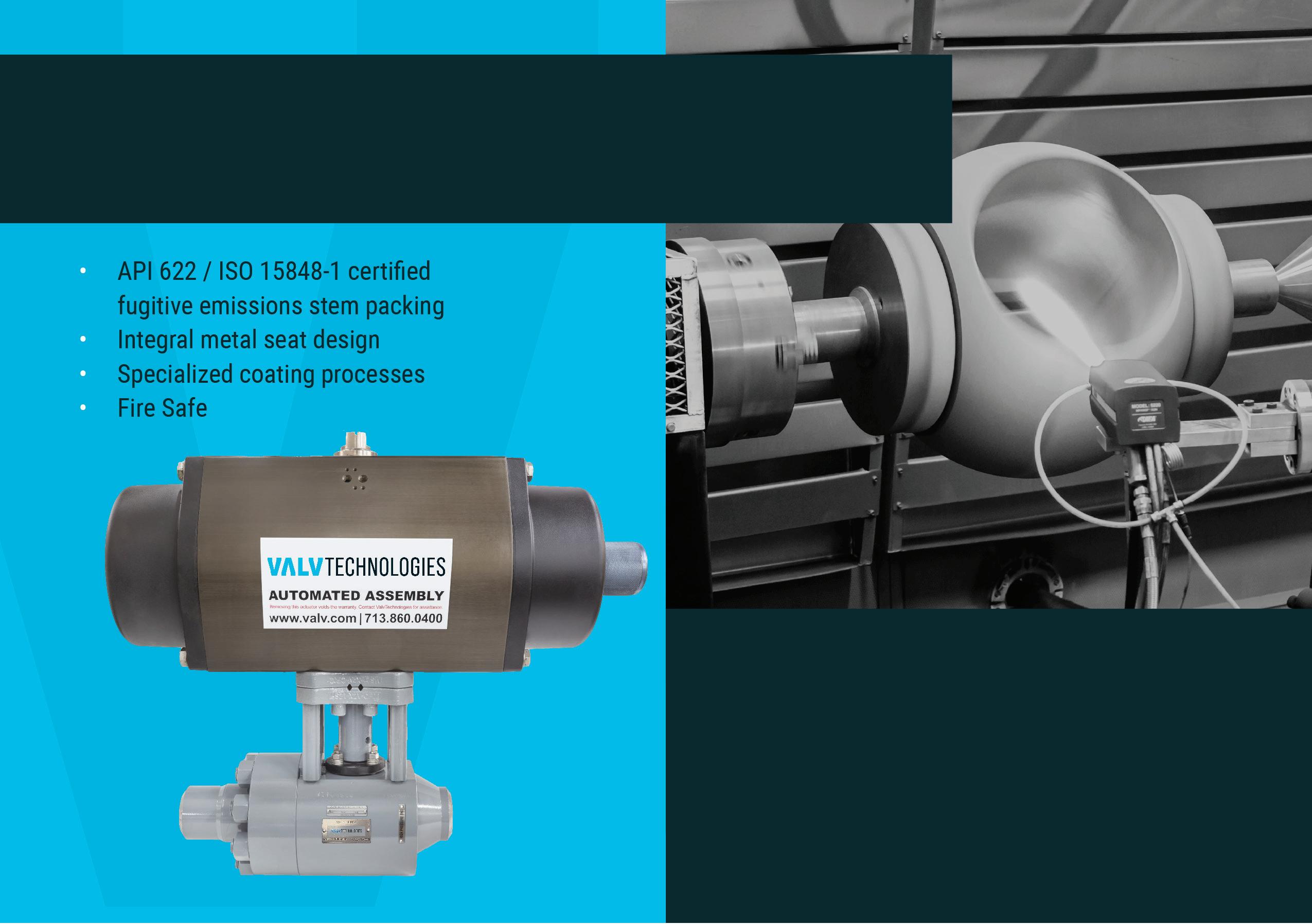
Another lighthouse project is the H2Global Foundation. Green hydrogen is still scarce and the development of a future hydrogen market, its legal framework, and the prices associated with its production are difficult to predict. For this reason, the H2Global Foundation was established in June 2021 to promote the global market ramp-up for hydrogen. The Federal German Government is allocating a total of €900 million for this purpose. A so-called ‘double auction model’ is used to bridge the difference between the high world market prices for hydrogen and the lower prices at which it is marketed regionally and used economically, providing both suppliers and buyers with planning security.
All of these projects are already well underway, and will establish a strong network along the entire green hydrogen value chain in northern Germany. There are, however, a number of other new projects in the pipeline as well. One of them, which is set to be implemented soon, is an innovation centre for aviation and shipping, called ITZ Nord. It is a new
type of development, research and test environment to be used for start-ups, founders and SMEs in particular. Based in three locations in northern Germany, it will also develop regulations and standards, and provide services for hydrogen suppliers, manufacturers and developers. It will be subsidised with up to €70 million by the German government, until late 2024.
The abovementioned projects, along with others, can rely on strong support from existing R&D facilities. At present, within a radius of approximately 200 km, scientists are active at two dozen universities and universities of applied sciences, over 20 Fraunhofer Institutes, Helmholtz centres, energy research networks, or the DLR (German Aerospace Center). Several hundred companies are involved in the north German hydrogen strategy, ranging from global players to innovative start-ups and specialists. And much more is on the horizon. Together, they will act in concert to create a green hydrogen economy in northern Germany, with Hamburg as a central European sustainability hub that is capable of actively driving future technologies forward.
1. ‘Highlights from Northern Germany’, HY-5, https://www.hy-5.org/ en/hylights/
The author of this article would like to thank Birgit Steinbok, Editor at Hamburg News, for contributing to this article.
Lennart van der Burg and Piet Warnaar, TNO, discuss the future of offshore hydrogen production: what to expect, whether we will be capable of producing our hydrogen offshore, and what the key benefits and challenges will be.

Green hydrogen produced via electrolysis (generated by renewable electricity) is still in its early stages of development. The electrolyser market is where the solar energy market was at the beginning of this century, or even before that.
Globally, a total of 810 MW of solar capacity was installed in 2000, which grew by a factor of 1000 in just over two decades, to 843 GW in 2021.1 According to the IEA, the total installed electrolyser capacity globally was less than 300 MW in 2020.2 So, we are really at the beginning of the development of this sector, and it will need to show signs of a steep climb in order to quickly phase out fossil fuels and successfully fight our current climate crisis.
Multiple research questions still lie ahead. One of these questions is whether this hydrogen will only be produced onshore, or whether we might also be capable of offshore production. This article will provide an insight into the opportunities and barriers to overcome when it comes to offshore hydrogen production.
The Netherlands has set a target of having at least 3 GW of green hydrogen production capacity by 2030. This number may even grow to be a factor 2 or 3 larger, considering the European policy that 50% of the hydrogen produced

by 2035 is expected to be green. With respect to wind energy, it is forecast that we will have 4.5 GW of production capacity placed in the Dutch part of the North Sea by 2023. However, this is still only the beginning. Policy plans are in place to reach a total of 21 GW in 2030 3 , and much more is believed to be possible: a potential of 70 – 80 GW could be achieved in the Dutch part of the North Sea, to cover 20% of the Dutch North Sea’s surface area. The greater North Sea is an important wind energy source for the entirety of Europe. The big question is: how can we harvest, transport and store all of this wind energy effectively?
Currently, wind farms receive a high voltage electrical connection, and the electrons are then transported to shore and integrated into the energy system. The wind energy production, combined with solar energy, meets national baseload power demands, at times even resulting in a surplus of renewable electricity. It is at this point that flexibility is needed. According to a TNO report 4 , this flexibility can be found via a mix of sources (e-boilers, heat pumps, electric vehicles [EVs], electrolysers), and exported to neighbouring countries via interconnection cables, storage, and/or curtailment of renewable energy when there is a surplus and therefore extreme negative prices.
A study from the North Sea Wind Power Hub in 2022 shows that when (under certain cost assumptions) the production is 1.35 times the baseload electricity demand, it makes sense economically to develop dedicated electrolyser systems for when there are a large enough number of hours in the year that have a surplus of renewable electricity. 5 Basically, offshore wind development goes hand in hand with additional electrification across the different sectors, and green hydrogen production plays a central role here.
In response to this, the following question arises: where in the energy system will these electrolysers be placed? Could one possibility be nearby the current and expected future users of hydrogen onshore, and/or nearby the electricity production site, which will largely be offshore (see Figure 1)? A recent TNO study shows that when offshore electrolysers are allowed, the share of offshore hydrogen in the total hydrogen production ranges from
10 to 15%, and investments in offshore hydrogen entail relevant reductions in system costs.
At present, multiple companies are focusing on determining the optimal configuration for offshore hydrogen production. Initiatives such as the North Sea Energy programme in the Netherlands 6 , or AquaVentus initiatives in Germany 7 , are studying different scenarios. For the most part, these study programmes are comparing a wind farm with a high voltage connection and onshore hydrogen production facility vs a wind park with offshore hydrogen production and transport via a new or potentially existing pipeline.
In the AquaVentus study, the alternative of transportation of hydrogen by ship was also evaluated. The conclusion of both of the first studies is that for large groups of connected wind farms of multiple GW capacity and a large distance to the coast (> 150 km), offshore hydrogen production is the most attractive choice.
The main advantages are the lower cost of transporting the hydrogen vs transporting the electricity. Still, a number of questions remain. For example, which compressors would be required to ensure that the correct pressure (70 bar) is maintained for transporting such a large quantity of hydrogen? Other questions about the behaviour and life time of the electrolysers in offshore conditions, and the need for and cost of maintenance, also need to be asked. These questions will be answered in pilot projects such as Poshydon. 8 Here, a consortium led by TNO will build a MW-scale electrolyser, supplied by Nel Hydrogen, on an existing oil platform, producing hydrogen that will be injected into an existing natural gas pipeline and transported to shore.
Another crucial question is: what can we expect from the high promise of the potential of underground hydrogen storage both on- and offshore? There is a clear need for large-scale (seasonal) storage because, in the Netherlands for example, three times more energy is consumed in the winter compared with the summer season. In other countries, that balance can tip towards large-scale energy consumption during hot summers, due to air conditioning. In many countries, energy generated in one season will need to be stored and released in another season. As such, there is a requirement for safe, large-scale energy storage. A pre-feasibility study by TNO and EBN showed that there are no major showstoppers expected for offshore hydrogen storage in depleted gas fields, but a pilot project is crucial to providing final answers on the technical possibilities.9

In the aforementioned scenarios, the focus is mainly on producing this hydrogen on a floating platform located centrally in a wind park. New concepts are being developed whereby electrolyser technology is fully integrated into wind turbines. Wind turbines have been fully redesigned with a new rotor to generator combination (larger generator on a similar rotor), resulting
As the leading innovator, we continue to supply our customers with the technology, methods, and consultancy to make the best integrity management decisions for their assets. No matter what the future holds, renewable hydrogen as a flexible energy carrier plays a vital role in moving the industry further; we want to make sure you are ready.

in a higher output of MWh being converted to hydrogen inside the wind turbine. Each turbine has its own back-up power supply (a fuel cell), and only a gas pipe connection that delivers the hydrogen to a central platform for further compression and central transport. The advantages of having an integrated ‘hydrogen turbine’ are that it generates more energy out of the available wind than a traditional electron wind turbine, and that it reduces a number of conversion steps, eliminating some of the AC/DC convertors and power transformers within the wind turbine.
Various ongoing R&D projects are working towards the first offshore pilots. In the Oyster project in Grimsby, England, Siemens Gamesa, Orsted and ITM are working together on setting up a demonstration project. 10 In Aberdeen, Scotland, Vattenfall is working on a pilot project integrating an electrolyser into an existing offshore Vestas wind turbine. 11 The aim is for only the foundation of the turbine to be adapted, and for the electrolyser to be placed on the tower’s exterior, on the existing jacket, far above sea level. This will make installation, operation and maintenance relatively easy. The electrolyser supplier is yet to be selected, and planned commission will be some time in 2023.
A Dutch company, Hygro, was one of the first to use a ‘hydrogen wind turbine’ supported by TNO, during a feasibility study in 2017 12 , and a test prototype on the TNO
test site in Wieringermeer, the Netherlands. 11 Funded by the Norwegian government, the ‘Deep Purple’ pilot project was launched. TechnipFMC worked together with Nel Hydrogen, amongst others. 13
Beside pilot projects in the UK, Norway, the Netherlands and Germany, there are also ongoing experiments in France. Off the coast of Le Croisic in Nantes, start-up company Lhyfe is setting up an offshore hydrogen test site on a floating platform, powered by a floating offshore wind turbine. 14 An electrolyser with a capacity of 1 MW will be supplied by the US company, Plug Power. To fully utilise wind energy potential, far offshore floating platforms may become a solution when the current technology of monopiles or jackets can no longer be deployed economically. New concepts of floating hydrogen wind turbines are being developed by different companies such as Equinor, Eolfi, Principal Power and ERM Dolphyn 15 , amongst others. The expected next steps will show more advanced concepts, whereby existing wind turbines will not be retrofitted but will instead be developed and optimised to include a fully-integrated electrolyser.

The Poshydon, Oyster, Lhyfe and Deep Purple projects have all chosen to use PEM electrolyser technology for their pilots (see Figure 2). For Vattenfall’s project in Aberdeen, the electrolyser technology has not yet been decided. The main reason for choosing PEM technology is its more compact design, which results in a lower physical footprint, as well as its ability to cope with flexible wind energy loads due to its capacity to quickly ramp up and down in a split second. Nevertheless, alkaline technology developers such as Green Hydrogen Systems are looking at offshore applications. In the company’s GreenHyScale project, a 7.5 MW high-pressure alkaline electrolyser for offshore applications has been developed and is planned for operation by the end of 2025. 16
Figure 2. A PEM electrolyser R&D short stack developed by TNO and Hydron, to be used to test novel components on an industrial-scale (source: TNO).

It is expected that much more innovation will take place in offshore hydrogen production. This is also stimulated by multiple government incentives. In mid-2022, Germany published a first tender ‘Sen-1’ aimed at the realisation of offshore electrolysers. 17 In this tender, the use of any cable to transport the energy outside the wind turbine is not permitted; rather, other energy carriers are required. The criteria for selection are: cost of energy, scalability, environmental effects, energy efficiency, and the expected annual volume of energy of the final energy carrier at the handover point. Another criterium for future tender and innovation projects should be the amount of knowledge sharing, as it would be a good idea to use these government-supported projects to publicly share the learnings across the sector. This is something that TNO and other research organisations are looking at in the HySpeedInnovation initiative.
For a full list of references, please visit: https://www. globalhydrogenreview.com/hydrogen/04112022/onshore-vsoffshore-what-lies-ahead--references/
The drive to decarbonise is ushering in new ways to produce hydrogen. Traditionally, hydrogen has been produced for heavy industry by industrial gas suppliers, with supplier and user often in close proximity. Green hydrogen allows for more distributed production in more diverse locations, serving a broadening client base.
This has heralded a slew of new projects – many first-of-a-kind – and new entrants into the hydrogen market. A number of renewable energy companies seeking to participate in the burgeoning hydrogen economy are among the new entrants. This article explores six core considerations that require serious attention in a project’s earliest stages to ensure a successful outcome.
Safety considerations are vital for a green hydrogen project. From the project’s earliest phases onwards, safety compliance has to be integrated into planning. Safety compliance is a potentially steep learning curve for green hydrogen projects because this is a fast-developing area, many aspects of which are not yet covered by designated safety regulations. As such, in many areas, existing codes and regulations are being applied to projects for which they were not originally designed. This means that actions and requirements are not always explicit, and in comparison to more established types of project, more time and effort is required to understand what compliance entails.

Developers and owners need to establish a full and clear understanding of what health and safety regulators want to know in order to authorise project construction and operations. In Black & Veatch’s experience, understanding how the requirements of the Control of Major Accident Hazards (COMAH) regulations apply to green hydrogen projects requires a significant amount of time and attention. The amount of hydrogen being stored, for example, has a significant effect on the measures that the regulations require, and thus influences other elements of the project. COMAH regulations apply within the EU and many other European countries.

For owners and developers of renewable energy projects, green hydrogen offers an attractive alternative to selling

power, especially in light of the forecasted growth in demand for green hydrogen. However, a clear understanding of the short-to-medium-term market for the chemical is needed, which considers both local demand and markets further afield. This analysis should encompass level of demand, types of use, and the relationship between patterns of demand and your hydrogen production profile. The latter factor will influence areas such as the project’s hydrogen storage capacity, as well as potential customer base.
Options for transporting hydrogen is another factor that supports an understanding of how a project’s product can be used. Although the prospects for green hydrogen consumption are incredibly strong, demand in many areas is currently low. However, this will almost certainly alter the rate of change that needs to be factored into a project’s business plan. Black & Veatch found that local market characteristics for one green hydrogen project, for example, meant that converting green hydrogen to green ammonia in situ resulted in a more commercially-viable product.
It is important to include levelised cost of energy analysis and levelised cost of hydrogen analysis in your planning, or a commitment to undertake them. Doing the research to ascertain energy costs and a per kg cost for your product will inform the creation of an accurate and robust business plan, and an understanding of the price points required to reach your business goals. There are two physical hydrogen storage options: compressed or liquefied. Due to the fact that your choice of storage option will have significant implications on project cost and end use opportunities, storage needs to be given careful consideration during the very early stages of project development. A business plan including these types of detail will help attract and reassure investors.
An abundant and reliable water supply is essential for green hydrogen production.
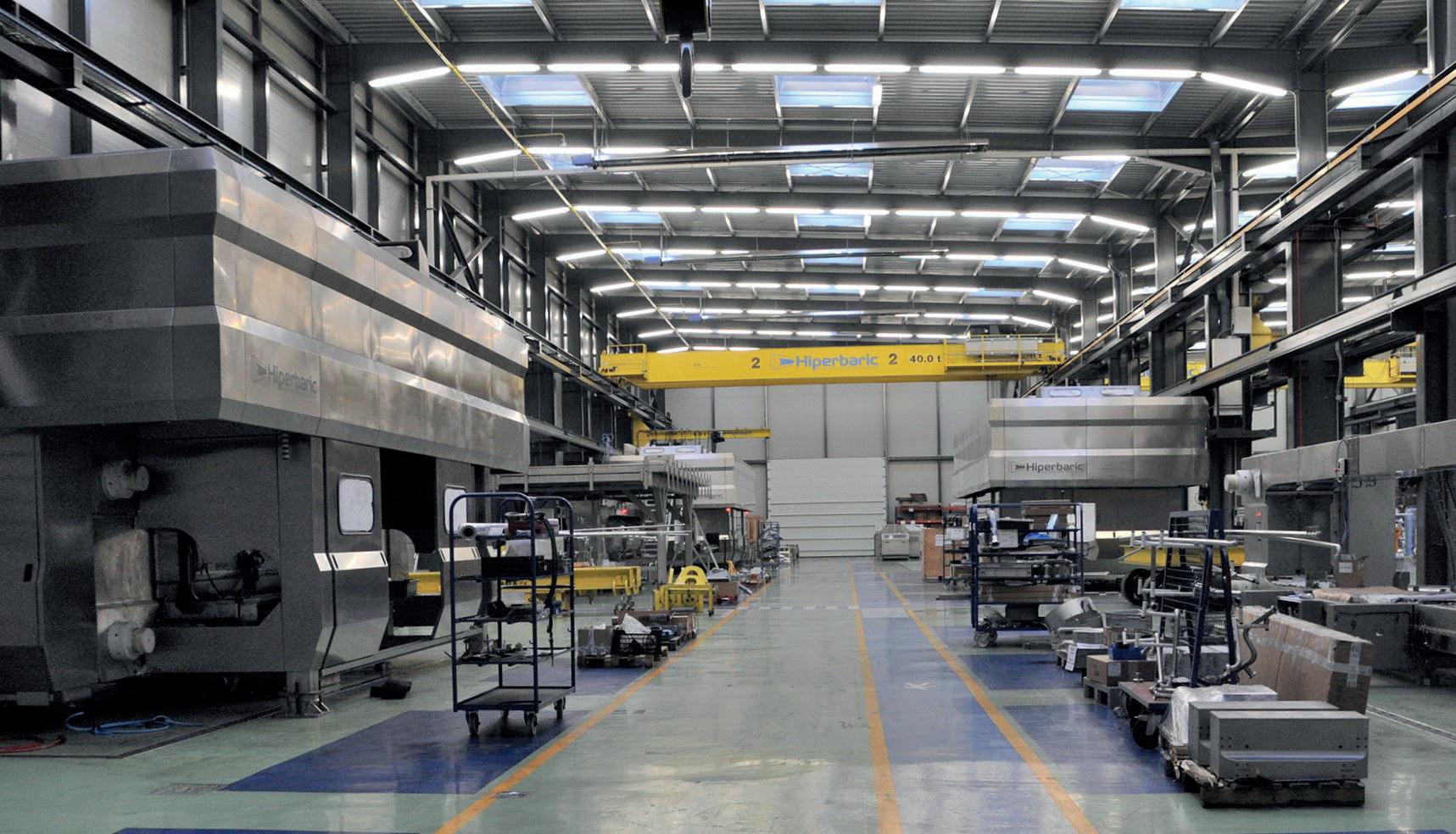



Black & Veatch’s six core considerations are rooted in real-world green hydrogen project experience. Here are details of some of those projects.
Mercury Renewables is developing one of Ireland’s first co-located onshore wind farm and hydrogen electrolysis plants (Figure 1). A 75 MW wind farm will power an electrolyser plant generating green hydrogen. Black & Veatch’s initial role in the project has been the feasibility studies that inform all aspects of the hydrogen development.
Black & Veatch’s early involvement has been to help Mercury understand which combination of electrolyser technology and size, as well as hydrogen storage and transport options – and water supply alternatives – best meets its business goals for the project. This is being achieved through the development of multiple scenario studies and conceptual site layouts.
Once the optimal configuration is identified, Black & Veatch will develop an outline design for the facility that is sympathetic to the local surroundings; and support engagement with the local community, as well as work to ensure the plant’s safe operation.
Black & Veatch is currently building 245 MW of electrolysis capacity across two projects, both scheduled for commercial operation before 2025. To put that number into perspective, the company is nearly doubling the world’s electrolysis capacity with its engineering, procurement and construction (EPC) projects.
These projects include the world’s largest green hydrogen production and storage hub. The ACES-Delta hydrogen hub, a joint venture comprised of Mitsubishi Power and Magnum Development, will initially be designed to convert more than 220 MW of renewable energy daily to 100 t of
High-purity water is one of the feedstocks needed for electrolysis. The quantity of water consumed differs depending on the application, but roughly 9800 l of demineralised and deionised water is required for each tonne of green hydrogen produced. In addition to being a feedstock, water is also necessary for cooling the electrolysers and other equipment such as compressors. It is vital to know whether sufficient water is available to support the capacity of electrolysis planned.
Making stakeholders aware of your intentions early on in the development of a green hydrogen project will give you early insight into concerns that may potentially disrupt progress. More importantly, it will give you time to address concerns before they become a major issue. You will have the opportunity to engage, inform and influence parties with reservations about your project and, if necessary, amend your plans to ameliorate those reservations at a time when change will engender fewer disruptions. This is an opportunity to show how you are supporting the drive to decarbonise, and reassure communities that hydrogen production, storage and distribution are tried and trusted processes – you are simply bringing a proven technology to a new setting.
green hydrogen that will be stored in two expansive salt caverns. The project is located in Delta, Utah, US (Figure 2).
Storing excess renewable energy as hydrogen in this manner yields a long-term and long-duration energy storage solution, complementing battery energy storage while allowing renewable energy to be deployed in times of highest demand. With hydrogen storage solutions, developers will be able to accommodate and optimise seasonal shifts of excess renewable energy.
Black & Veatch will engineer, procure, construct, start up and commission the facility. Mitsubishi Power will provide the hydrogen equipment integration, including the 220 MW of electrolysers.
The hydrogen storage hub is adjacent to the Intermountain Power Agency’s (IPA) IPP Renewal Project – an 840 MW, hydrogen-capable gas turbine, combined cycle power plant. With construction having begun in spring 2022, the ACES facility will enable operations at that power plant as it scales up from its initial 30% hydrogen fuel to an eventual 100%.
Black & Veatch is the owner’s engineer on the IPP Renewal Project, which marks one of the earliest installations of combustion turbine technology designed to use a high percentage of green hydrogen. The plant will generate power with high flexibility that will allow it to quickly ramp up and down in response to California’s challenging ‘duck curve,’ where the region’s high ratio of variable renewable energy presents challenges for stable grid operations. Whether dispatched for base load power, to follow load and renewable generation swings, or in response to long-duration energy storage needs that far exceed current battery capabilities, the IPP Renewal Project will support the transforming energy mix in western US.
Although you may have confidence in your wind farm or solar array’s 100 MW capacity rating, does this mean that 100 MW of electrolyser capacity is the best business choice. On this basis, maximum electrolysis can only be achieved when maximum power generation is being achieved, which will not be consistently possible with intermittent renewables. Hydrogen production calculations need to take this into account in order for customer expectations to be met, and to avoid unprofitable levels of redundant electrolyser capacity. Conversely, curtailment will be necessary if electrolyser capacity is significantly lower than typical power output. This will have a potentially adverse effect upon the cost of hydrogen production because that cost is highly dependent upon the cost of energy, which is increased when energy is wasted. Thus, it may be worth calculating not just energy yield, but also the generation profile.
The ability to export surplus power to the grid will help address the power and revenue loss that curtailment may cause, but the location of many renewable assets means that grid interconnection is not a viable prospect. For both scenarios, battery storage has a potentially valuable role to play. Ultimately, a trade-off between capital and commercial considerations is required to ascertain the optimal configuration for achieving the project’s business goals.
Establish the right balance between power output and electrolyser capacity
As public awareness of hydrogen’s potential as a clean alternative fuel grows, the improvement of electrolysers and increased availability of cost-competitive renewable energy will be essential to the green hydrogen industry’s growth. James Abrams, American Bureau of Shipping (ABS), offers his take.
Against the backdrop of the Paris Agreement and the resulting international commitment to limit the global mean temperature rise to below 2°C (and ideally 1.5°C), the onus is now on the energy sector to find cleaner ways of generating and distributing power that are both widely accessible and commercially viable.

Under its current administration, the US has realigned itself with the UN’s climate goals, setting a series of ambitious climate-oriented targets for 2030, including the use of 100% carbon pollution-free electricity, at least half of which will be supplied locally.
Hydrogen – traditionally used by industry as chemical feedstock – is gaining traction as a potential alternative fuel because it is an attractive proposition for energy storage, which could play a key role in future low-carbon energy systems by balancing intermittent supply with demand.
Indeed, due to its high energy density by weight, elemental abundance, and the potential to produce it at affordable costs, hydrogen is a promising option.
Central to the production of green hydrogen is water electrolysis, the process of using electricity to split water into its components, hydrogen and oxygen, using an electrolyser.
Electrolysers have a variety of configurations, but if green hydrogen is going to become a mainstream fixture in the energy mix, there are barriers to commercialisation that need to be addressed for each of them.
There are three common types of electrolysers, each with their own advantages and disadvantages.
Alkaline electrolysers have a long history of industry use and still represent the cheapest option to manufacture, while also having longer lifespans of up to 10 years. There are some drawbacks however, such as their large size, which makes them unsuitable for marine applications, as well as their relatively poor efficiency in comparison to other electrolyser types.

Solid oxide electrolyser cells (SOEC) require superheated steam as an input, and have an average lifespan of up to five years. They are smaller units but are currently the most expensive option to manufacture due to their high complexity and material requirements. They also have operating temperatures of as high as 1000°C, which can harm the overall efficiency of the hydrogen production process in many scenarios. However, there is potential to see them used alongside industrial processes that produce
significant amounts of waste heat, such as nuclear power generation.
Industry discussions have begun to centre around polymer electrolyte membrane (PEM) electrolysers. These are smaller electrolysers that are well suited for maritime use, operate at temperatures between 50 – 80°C, and are highly responsive to load changes. Typical lifespans for PEM electrolysers are shorter, at around three to four years, and are more expensive to construct than alkaline electrolysers.
Despite being the current leading solution in terms of viable electrolyser technology, the production of PEM electrolysers comes with the significant challenge of sourcing materials.
They contain relatively large quantities of rare earth metals such as platinum, titanium and, most critically, iridium. Mining for rare earth elements is notoriously difficult and subject to volatility of supply. Furthermore, the methods involved can produce large quantities of pollution and waste. The worldwide annual production of iridium is only 7 t, falling well short of the amounts needed to sustain the current PEM electrolyser project pipeline.
Furthermore, the role that rare earth metals play in terms of performance and durability by reducing anode corrosion cannot be easily replaced. At the moment, there is much emphasis on reducing reliance on costly or rare materials, while still improving the overall stack efficiency of electrolysers.
A developing technology similar to PEM electrolysers but with less expensive components are anion exchange membrane (AEM) electrolysers. These are showing some promise as they have the potential to be far cheaper to build and operate – however, they are not seeing much commercial development because of efficiency issues. If these challenges can be overcome, AEM electrolysers could replace PEM electrolysers as the backbone of the green hydrogen industry. AEM is still a fledgling technology though, and has yet to see serious industry use.
While greater cost and performance improvements can still be made with electrolysers, it would be inaccurate to

suggest that the future viability of green hydrogen rests solely on these developments. A greater determining factor is cost-effective access to the power needed to run them.
Green hydrogen, produced using renewable energy instead of fossil fuels, represents the gold standard in terms of emissions, but still requires significant investment and infrastructure development before it becomes cost-competitive with hydrogen produced using fossil fuels.
The numbers do not lie. Green hydrogen can cost four to eight times as much as hydrocarbon-derived hydrogen. Blue hydrogen, produced from fossil fuels with carbon capture systems, can be two to four times as expensive as grey hydrogen, which is produced using fossil fuels without carbon capture.
This underscores the strong competition that electrolysers face from other methods of hydrogen production such as coal gasification and steam methane reforming (SMR).
As a result, it is unsurprising to see that around 4% of the hydrogen produced today is green, with the remaining 96% being split across blue (around 25%) and grey (around 71%).
And because blue hydrogen, which uses carbon capture to reduce its emissions, tends to be cheaper to produce than green hydrogen, much of the focus is being placed here as a means of accelerating the energy transition.

There is some optimism that green hydrogen costs will become more competitive in the future, with expectations that we will see something in the region of US$2/kg in most areas by 2030, and even US$1/kg in
parts of the world with cheaper renewable energy, such as Europe. The Energy Transitions Commission is even more optimistic, forecasting that green hydrogen will become cheaper than blue hydrogen in some areas by 2030, and most of the world in 2050.
The cost of electrolysers, of course, will have a bearing on whether these forecasts ring true. Once again there are several predictions being made here, especially around alkaline electrolysers, which remain the ‘mainstream’ for now. Here, the International Energy Agency (IEA) and International Renewable Energy Agency (IRENA) indicate that prices will drop from US$950/kW to US$625 by 2030. However, for green hydrogen to become economically on par with blue and grey hydrogen, that price point needs to drop to something closer to US$125/kW.
These challenges considered, the industry is still cautiously optimistic about the direction of travel when it comes to electrolyser technology and its readiness to facilitate green hydrogen production.
ABS is currently involved in a range of projects exploring the application of hydrogen. This includes an Approval in Principle review for an offshore hydrogen production facility.
In addition to this, the company continues to offer its in-house knowledge and experience in assisting parties with risk assessments, new technology qualification, and other similar services aimed at helping clients develop and implement their own electrolysers.
There is a long way to go before green hydrogen reaches a competitive equilibrium with blue hydrogen, and the US government’s target of US$1/kg of green hydrogen by 2030 is certainly bold. There is no problem in aiming high; but it means we cannot afford to coast our way through the rest of the decade – a concerted effort involving multiple public and private stakeholders will be needed.
While hydrogen is widely used in some industries, its potential is vastly untapped in others. With decades of hydrogen project experience — from production and utilization through storage and distribution — we understand the complexities of the hydrogen economy and how to navigate the numerous pathways toward a decarbonized future.
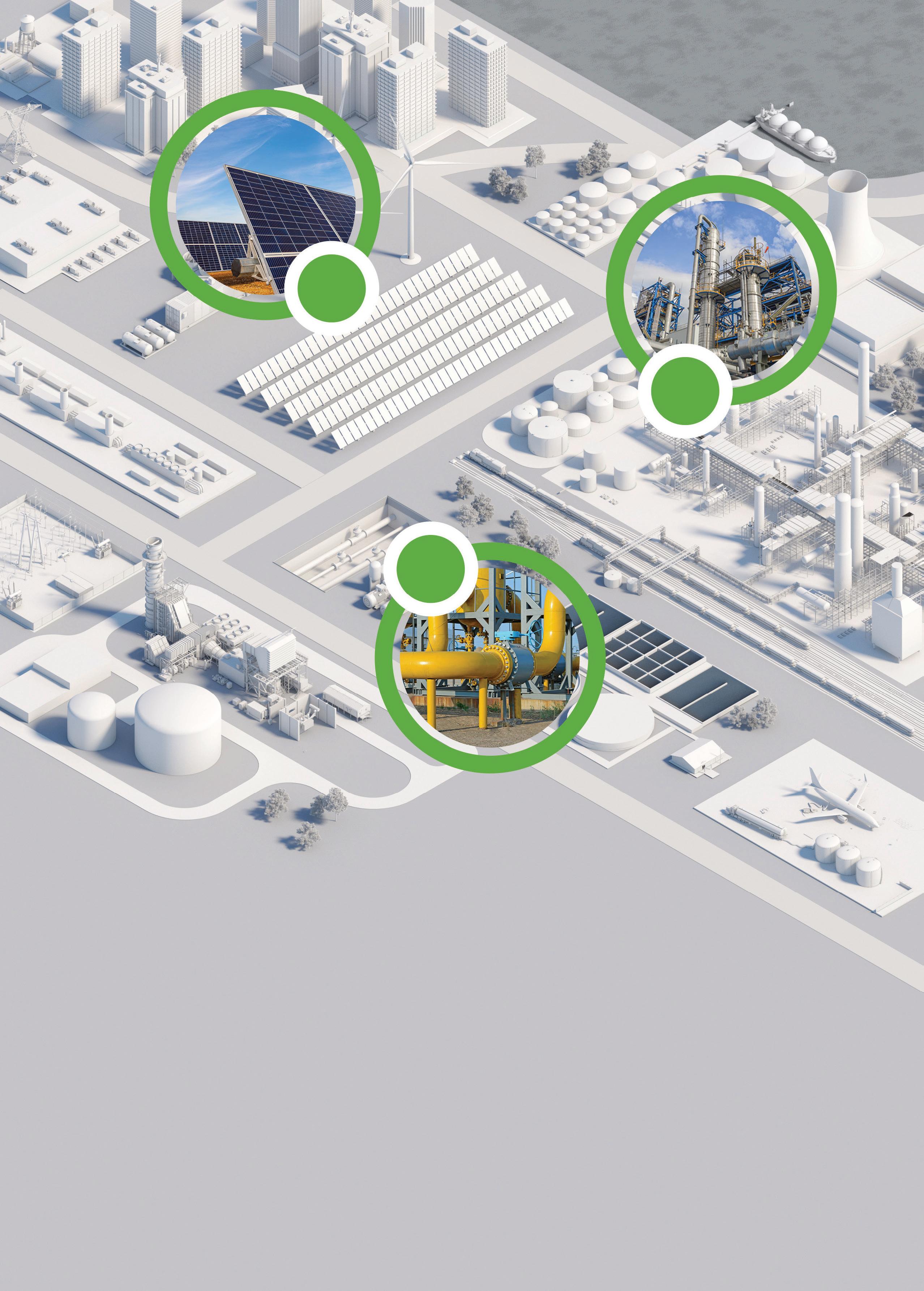

Two of the key issues faced by society today are the need to reduce carbon dioxide (CO2) emissions to combat the rapid progression of climate change, and addressing concerns related to security of energy supply. There is a clear consensus that emissions will need to be cut across all sectors of the economy, including those that are considered hard-to-abate. Hydrogen can be the solution to both issues, as it can be produced with local resources and with a low CO2 emission footprint. It can be used as a feedstock, a reduction agent, and as an energy vector in many of these hard-to-abate sectors, such as the steel and chemical industries, and heavy-duty transport. As such, the production of clean hydrogen from local resources will play a crucial role in meeting decarbonisation targets, while simultaneously improving our security of supply.
Traditionally, hydrogen has been produced via high-emission processes that make use of hydrocarbon molecules. Hydrogen production plants – primarily steam reforming plants – have thus historically enjoyed a stable and steady supply of coal, oil or gas feedstock delivered by well-developed infrastructure to store and transport hydrocarbons at moderate costs. With the urgency to decarbonise all sectors of the economy, one answer to reducing emissions in the production of hydrogen and its derivatives is the replacement of hydrocarbon-based hydrogen production with the production of hydrogen through the electrolysis of water coupled with renewable electricity produced domestically, in the interest of energy security.

In this context, the intermittency of renewables is quickly becoming a topical challenge for industrial sectors pursuing renewable hydrogen and its derivatives. So, while the intermittency of renewable electricity has been affecting the design of electricity grid systems for more than a decade, such intermittency has not influenced the design of industrial plants within the chemical industries thus far. This includes hydrogen production plants.
The discontinuity in renewable electricity sources poses both a technical and an economical challenge. From a technical point of view, storage solutions will have to be implemented to transform an intermittent source into a steady stream of electricity for hydrogen production, and a steady stream of hydrogen for the production of its derivatives, such as ammonia and methanol.
In turn, this required storage – if not optimally sized – could significantly increase the costs of plants, thus making their construction unviable.
To effectively tackle these uncertainties, adequate tools that can support players in the hydrogen production space are imperative. There are two main phases behind this. First, the initial design of the plant and storage, which will have to consider all downstream and upstream components of the hydrogen production chain. Second, the dynamic adjustment of production processes and plant operations to accommodate short-term variability, both in renewable energy supply and in renewable energy prices. These two issues cannot be tackled in isolation; rather, they require an all-encompassing approach that looks at minimising the plant’s total cost of ownership.
With regards to the initial design of the plant, one solution to smooth out the renewable energy supply profile is the connection to the grid. Such connections can help mitigate the intermittency of renewable electricity supply through grid-based storage systems, demand-side response, and the geographical and technological diversity of renewable energy sources. However, much of the flexibility of the electricity grid is provided by thermal power plants. As such, a connection to the grid could lead to the production of at least partially unclean hydrogen.
The other instrument available to mitigate the fluctuations of renewables is energy storage at the plant’s site. Importantly, a key feature of hydrogen production plants is that energy can be stored both upstream and downstream of the electrolyser. Storage upstream of the electrolyser involves electrochemical, thermal, and/or mechanical energy storage systems. Storage downstream of the electrolyser entails the use of hydrogen buffers – a buffer being the intentional overproduction and storage of hydrogen so that it can be used, as either feedstock and/or energy source, to overcome intermittency. Both types of storage solutions significantly increase the cost of the product, due to their considerable impact on the CAPEX of the plant.

Therefore, in this first phase of plant design, the optimal sizing of all plant components (i.e. photovoltaic [PV] and/or wind farms, the electrolyser, the electricity and hydrogen storage systems, and the hydrogen derivative plant downstream of the hydrogen production section) need to be determined, in combination with the optimal use of the grid connection.
In collaboration with OXGATE at the University of Oxford, UK, and Bocconi University, Italy, NextChem has developed a CAPEX/OPEX optimisation tool called ArcHy (short for Architecture of Hydrogen systems), to provide answers to these questions during the initial plant design.
ArcHy inputs renewable energy supply profiles and calculates the optimal size of the different plant components and the ideal exploitation of electric energy from the grid. Optimisation of additional variables, such as the renewable energy mix and

technical operating parameters (e.g. the maximum rate of load ramping and the minimum process load), is also a function of this tool.
ArcHy’s optimisation process is split into several steps. First, the problem is specified by defining the desired product (whether the plant is set to produce pure hydrogen or a derivative), the geographical location of the plant, and any constraint related to a specific project (e.g. maximum CAPEX, land availability). Second, accurate wind speed and solar irradiation data is exploited from the past 40 years at the specific geographical location to determine renewable power profiles at the yearly level, and with hourly granularity. This model is then fed a combination of power profiles that spans a substantial part of the distribution of weather outcomes. Third, the CAPEX of all units is estimated using factorial methods based on a vast internal cost database.
Next, a set of viable plant configurations is created. These vary in the components that are included (i.e. PV and/or wind farms, the electrolyser, the electricity and hydrogen storage systems, and the hydrogen derivative plant downstream of the hydrogen production section). For each configuration, the model calculates the optimal size of each of the components, as well as a dedicated profile of electricity injection and withdrawal from the grid (should a connection to the grid be deemed beneficial for the economics of the plant) to minimise the levelised cost of hydrogen or its derivatives (LCO-X). This is done by setting the objective of fulfilling the annual demand of the desired product (pure hydrogen or a derivative product) for the entire lifespan of the plant, at the minimum cost, while keeping within the technically-feasible operating conditions of the plant in each hour of the modelled timeframe. As a result, the mass of hydrogen or its derivatives that is generated at any given hour is also able to be calculated. Finally, from all viable plant configurations for which the optimised sizing of components are obtained, the ones that feature a low LCO-X are retained and further analysed.
Thanks to this approach, several plant configurations can be assessed, and an accurate estimation of optimal sizes of key components can be obtained within a short period of time. This is key when assessing opportunities at their inception, so that configurations that show an acceptable LCO-X can be analysed further, while those that are identified as too expensive can be discarded early on.
After the selection of one or more plant configurations that appear promising, two things must happen. First, the physical-chemical behaviours of the plant processes must be simulated. Second, whether these configurations are compatible with plant-level processes that are robust from a chemical and physical perspective must be tested. This improves shareholder and lender confidence in the quality of the business case, and this is achieved by simulating the physical-chemical behaviours underpinning the plant-level processes. In this step, the cost estimates can be further refined, as some of the plant’s equipment in the configuration can be adjusted


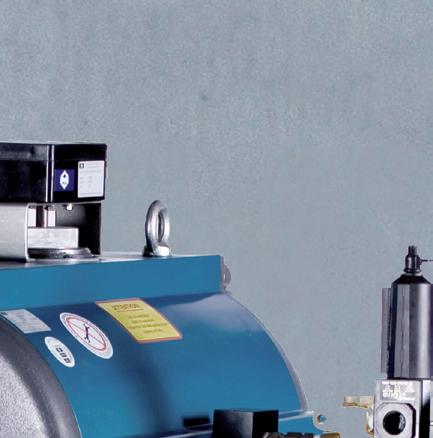









for technical compatibility. The aforementioned simulation is performed at a second-by-second or minute-by-minute granularity, to yield more accurate data on the mass and energy balances.
For this purpose, NextChem is developing a second digital tool, HyPer (which stands for Hydrogen Performance simulator), in collaboration with the University of Calabria, Italy. This tool can simulate the same hydrogen production chain as ArcHy, but is customised for specific components through both a static and dynamic process approach. With this tool, three main challenges that typically arise during the design of hydrogen production plants can be tackled. First, the need to improve the bankability of green hydrogen-based projects by substantiating the availability, reliability and production capacity/profile of the hydrogen plant, irrespective of the intermittency of renewable energy sources. Second, the need to assess the design of green hydrogen-based plants, with the objective of realising a safe, reliable and operable installation at the lowest total cost of ownership. Third, being able to guarantee the contractual performances of green hydrogen-based plants under the expected operating conditions.
To provide a solution to these challenges, NextChem built HyPer primarily as a detailed design tool, and secondly as a real-time optimisation tool, by leveraging its expertise in rigorous first-principle-based process models, and building upon a track record in the development and application of digital technologies for minimising plants’ OPEX. HyPer exploits detailed quantitative information on interactions between all plant components and for each piece of equipment, as part of a multi-physics approach that consists of six primary domains: fluid dynamics, thermodynamics, electrochemistry, thermal, electrical, and control strategy.
Starting from the configurations’ parameters that emerge from ArcHy’s optimisation, HyPer assesses whether the sizing of all of the plant’s components is both compatible and optimised.1 This is achieved by looking at the physical-chemical behaviour of the processes at the steady state, as well during transition phases between one plant state in a given second or minute vs the next. Such analysis is critical for both equipment and process streams, due to the fluctuations in the supply of renewable electricity, which have a knock-on effect on the electrolyser, the hydrogen storage, and the hydrogen derivative plant downstream.
HyPer has a modular structure based on building blocks created on specific equipment, and communication blocks using interconnected mathematical modules. These blocks are customised to specific equipment that is available on the market,
and are key to going beyond existing commercial tools (typically populated by generic building blocks with a lower level of accuracy in matching the real equipment performances). They perform the type of simulations required by green hydrogen-based plants, with the level of detail needed to predict the overall plant performances both at steady states and during transitory phases. The modularity of the structure also makes HyPer a versatile tool that is suitable for a large variety of applications, as it permits the reusability and scalability of hydrogen plant blocks of varying sizes.
More specifically, HyPer can be divided into three sections. The first section is related to both electricity production and storage. For this section, a grid connection under a green power purchase agreement (PPA), a connection to an off-grid renewable power plant (with a detailed PV and wind electricity production model), and battery storage systems can be simulated. The second section deals with hydrogen production and storage. For this, NextChem developed a highly-detailed model capable of accurately replicating distinct types of electrolysers (alkaline, PEM2, SOEC2), hydrogen purification and compression packages, and several hydrogen storage technologies. Finally, the last section is dedicated to downstream off-taker units, i.e. a green methanol plant, green ammonia plant, green power plant, refinery for sustainable fuel, etc.
HyPer is currently under development, following a phased approach. The first phase of development, which has already been completed, was dedicated to the construction of selected ad hoc building blocks that are not part of standard commercial tools. In the second phase, the performance of HyPer will be validated using data on the physical-chemical behaviours of the processes of a real pilot plant. A third phase will be dedicated to achieving the industrialisation of HyPer as an offline design tool. To do so, the library of building blocks will be updated and expanded to cover a sizeable portion of technologies as they become available. In the fourth and final phase, HyPer will be turned into an online tool for real-time optimisation of plant performances.
Going forward, NextChem will continue to develop and expand its newly-created tools, ArcHy and HyPer. This integrated approach to plant design and plant performance simulation is believed to be key to supporting investors and developers’ strategic decisions. Accurate and detailed wind speed, solar irradiation, and component cost data, alongside a robust approach to plant optimisation, are distinctive features of ArcHy. The capability of simulating the physical and chemical behaviour of an end-to-end hydrogen production chain, both at the steady state and in the transition between states, with customised and validated blocks, make HyPer stand out. It is hoped that the efforts behind developing these tools will contribute to building the necessary confidence amongst all players in the hydrogen space, and attract more investments in clean hydrogen projects.

1. Plant components are the PV and/or wind farms, and/or electricity withdrawn from the grid, the energy storage, the electrolyser, and hydrogen storage systems, and the hydrogen derivative plant downstream of the hydrogen production section.
2. Currently under development.
Bruno Roche, ABB, France, explains how leveraging digital capabilities can aid the scale-up of low-carbon hydrogen production to accelerate decarbonisation.
Aholistic view of hydrogen production, close collaboration between all stakeholders, and the integration of digital, automation and electrification solutions are all essential to successfully making gigawatt-scale green hydrogen plants a reality in order to

accelerate industrial decarbonisation. Decarbonising heavy industries to reduce harmful greenhouse gas emissions is central to efforts that are focused on limiting the global temperature rise to 1.5°C, in line with the 2015 Paris Agreement goals, and transition the world from fossil fuels such as oil and coal to renewables such as wind and solar photovoltaic (PV).
The recent impact of the conflict in Ukraine on economies, energy costs and supplies has further underlined the importance of energy security and low-carbon fossil fuel alternatives. Unfortunately, there is no silver bullet to the threat posed by climate change; the solution will require a dynamic mix of clean energies, not to mention collaboration and knowledge-sharing on an unprecedented scale.
Until relatively recently, hydrogen has been viewed as something of a controversial, niche element of the energy transition. However, there is now general agreement that its potential uses – directly as a carbon-free fuel or to store and transport renewable energy – will make it invaluable in lowering man-made carbon emissions. It can play a key role in integrating renewable energy into industry value chains around the world, particularly in hard-to-abate industries that cannot readily shift to electrification. 1
It is believed that hydrogen – especially when generated from renewable sources – holds tremendous potential to help decarbonise the global economy, reach climate goals, and improve the reliability and resilience of our energy systems. There are many ways that this can be achieved. For example, low-carbon hydrogen could be used as a replacement for fossil fuel combustion or heat generation in heavy industries such as cement and petrochemicals, or as a carrier of renewable energy from where it is generated (solar, wind, hydro, etc) to where it is consumed.
If used directly as a fuel, it emits zero carbon dioxide (CO 2 ) and produces almost no other air pollutants in the process. It can also be utilised to store and transport energy generated from renewable sources – either as a gas or a liquid – in order to counteract intermittency, i.e. when the wind does not blow, or the sun does not shine. 2
Another positive is that the production, liquification and/or compression, transportation and consumption of all colour varieties is a known, stable process that uses mature technology and infrastructure. Work is already underway into transporting hydrogen via existing and refurbished gas pipelines.
While grey hydrogen is mainly generated from natural gas via steam methane reforming (SMR), blue hydrogen is produced by carbon capture. Both processes are far from carbon-neutral, however. For this reason, attention is currently focused on carbon-neutral ‘blue-green’ bio-hydrogen using SMR, but with bio-feedstocks. With the addition of carbon capture, this type of hydrogen is even carbon negative. Green hydrogen, meanwhile, is generated using water electrolysis and energy from renewable sources. While green is a goal, all forms of
hydrogen will play their part as the industry scales up to meet growing demand, and there will likely be a mix of technological approaches and processes involving all colours of hydrogen while the industry takes shape. 2
However, there are two big problems holding hydrogen back: supply volumes are too low, and costs are too high. The beginnings of a new value chain may be grounded in proven technology, but OEMs are struggling to cope with the demand for giant electrolyser units at present, leading to a growing shortage for green hydrogen. Scale-up is therefore the key piece of the puzzle to provide the quantities of green hydrogen required for industrial end uses, such as feedstocks and fuel, at an affordable price. In addition to this, developing end use solutions to help expand hydrogen use worldwide is also of high importance.
The opportunities are enormous: IHS Markit, now part of S&P Global, estimates that capital spending on low-carbon hydrogen production could reach US$265 billion by 2030. 3 However, right now there is simply not enough available. In response to this, kilowatt and megawatt plants are becoming common, gigawatt-sized green hydrogen plants are being planned, and multi-gigawatt-scale facilities are on the not-so-distant horizon. Every six months, the number of green hydrolysis projects is doubling, yet this is only the beginning of what is needed.


Today, the installed base of hydrogen electrolysers powered by renewable energy is just 0.3 GW, with a projected 40 GW to be commissioned by 2030, according to Bloomberg New Energy Finance’s Hydrogen Production Database. However, recent reports show that this project pipeline is nowhere near the exponential 850 GW of expected growth yet to be materialised in order for hydrogen to play its part in a net zero emission scenario. 4
For hydrogen to fulfil its vast potential, giga-factories must become the norm. Bigger production plants and volumes translate into much-needed economies of scale that lower the unit cost, and help bring down the levelised cost per kg of green hydrogen production.
Australia and the US lead the way with multi-gigawatt project announcements, the largest being from Green Hydrogen International with the 60 GW Hydrogen City – an integrated production, storage and transport hub that is set to produce more than 3 billion kg/yr of green hydrogen. It will be turned into green ammonia, sustainable aviation fuel (SAF) and other products, or delivered by pipeline to hydrogen power plants and other users in Texas, US. 5
Hydrogen City, for example, will receive electricity from a 5 GW/yr RuggedCell electrolyser factory constructed by Canadian company, Hydrogen Optimized. In October 2022, ABB and Hydrogen Optimized signed an agreement to jointly explore the development of large-scale green hydrogen production connected to the electrical grid. 6
Measurement performance for methanation
Measurement performance for methanation
Methanation, the conversion of H2 and CO2 into methane, the main component of natural gas, is an extremely effective technique in helping realize decarbonization.
Methanation, the conversion of H2 and CO2 into methane, the main component of natural gas, is an extremely effective technique in helping realize decarbonization.


It is necessary to monitor the concentrations of H2, CO2, and CH4 generated during the methanation process.
It is necessary to monitor the concentrations of H2, CO2, and CH4 generated during the methanation process.
To move ahead with decarbonization, it is necessary to know how much CO2 is generated when flaring gas.
To move ahead with decarbonization, it is necessary to know how much CO2 is generated when flaring gas.
From figuring out the amount of CO2 that is released during gas flaring to helping find ways of recycling flare gas into usable energy (fuel gas), you will find a solution to your problem in RIKEN KEIKI’s gas measurement system.
From figuring out the amount of CO2 that is released during gas flaring to helping find ways of recycling flare gas into usable energy (fuel gas), you will find a solution to your problem in RIKEN KEIKI’s gas measurement system.
Discover
Discover the Riken Keiki Gas Sensor Technology



To find out more, or to get help with a query, please contact the Riken Keiki on +813 3966 1113, or email at intdept@rikenkeiki.co.jp
To find out more, or to get help with a query, please contact Riken Keiki on +813 3966 1113, or email at intdept@rikenkeiki.co.jp
Elsewhere in the US, ABB is working with Plug Power to apply its experience in electrification to enable power for two major hydrogen production plants, which are set to produce 60 tpd of green hydrogen. The first plant, Project Gateway, is expected to become the largest green hydrogen production facility in the US. The hydrogen produced from the two facilities will be used for logistics and transportation, specifically to replace fossil fuels in on-road applications such as heavy-duty freight vehicles and forklifts.
In China, there is a rapid increase of plants in operation, using the next generation of electrolyser with larger and larger modules. One example here is Peric, a partner with whom ABB has commissioned a first project, and who are in the execution and preparation phase for many more.
However, the race for the world’s largest hydrogen electrolyser is on. In Europe, following testing in Herøya, Norway, a single-stack, high-pressure alkaline unit will be able to produce 1100 normal m 3 /hr of green hydrogen. ABB is providing electrical equipment for this project, and has also signed a Memorandum of Understanding (MoU) with green hydrogen producer, Lhyfe, and wind power company, wpd, to establish Europe’s largest green hydrogen production facility. Lhyfe’s green hydrogen plant, powered by wpd’s offshore wind farm, is expected to produce around 240 tpd of hydrogen (equivalent to 60 000 bbl/yr of oil). ABB will provide automation and digital technologies to help lower production costs and enable the fastest possible route to scale-up.
When it comes to low-carbon hydrogen, the infrastructure to use and sequester CO 2 is necessary before carbon capture can be widely added to existing production or greenfield blue hydrogen production. The Northern Lights project in Norway will feature the world’s first open CO 2 transport and storage infrastructure, accelerating industrial decarbonisation and CO 2 removal by providing transport and permanent storage in undersea reservoirs. ABB’s automation, electrification and digital solutions are to be used, and there are plans to store over 5 million tpy of CO 2
Scaling up plants from megawatts to hundreds of megawatts, or even gigawatts, presents a new set of challenges – not just compared with smaller electrolysers, but also in relation to working processes, CAPEX and OPEX. It is important that operators consider the latter issue. The electricity to run a hydrogen plant, for example, will cost far more than the CAPEX over the long-term; in fact, more than 70% of the total OPEX to make 1 kg of hydrogen is the electricity cost to power the electrolyser. Return on investment will heavily depend on how efficiently the energy required to produce the hydrogen is managed and optimised.
Much of what is involved in undertaking this massive scale-up of electrolyser capacity is uncharted territory. This includes infrastructure and technology such as the electrical supply for AC/DC conversion, as well as
automation and digitalisation to produce green hydrogen at the lowest cost.
The beginning of this article mentioned that collaboration is crucial to the energy transition, and hydrogen scale-up is a compelling example of this. Companies must take a holistic view and partner with a technology specialist, one with deep domain knowledge of electrical and automation engineering, powerful project execution and safety skills, and the latest digitalisation and remote analysis tools.
ABB’s process automation and digitalisation portfolio – which encompasses distributed control and energy management systems, digitalisation software, power apparatus for motors and pumps, and sensors – enables high-efficiency operation while simultaneously checking for potential leakages.
To truly achieve low costs, and continuously reduce them over time, the complex scale-up of green hydrogen-based electrical energy systems will require superior project execution. ABB’s Adaptive Execution™ methods can drive better cost, material and resource efficiencies by integrating expert teams, new technologies, agile processes, shared learnings, and proven methodologies. This may also include the task of integrating the green hydrogen into existing, non-greenfield processes and plants.
Knowledge-sharing between technology providers, EPCs, investors and operators is already leading to new innovations to support large-scale, renewable-based hydrogen use in industry. ABB, IBM and Worley, for example, have joined forces to create a repeatable, end-to-end approach known as ‘Green Hydrogen in a Box’. The integrated, digitally-enabled solution enables plant owners to build green hydrogen assets quicker, cheaper and more safely, and operate them with increased efficiency.
Scaling up hydrogen production to meet rising demand for renewable power is arguably the greatest challenge facing the nascent hydrogen industry. However, the sector – in partnership with technology vendors with industry expertise and knowledge – is rising to meet that challenge. This type of collaboration is essential to scaling up the production of clean, green hydrogen both quickly and cost-effectively, and will make a world of difference in ensuring that its potential as an integral part of the energy transition is fully realised.
1. ‘Hydrogen – the key to a low-carbon future’, ABB, https://new. abb.com/process-automation/energy-industries/hydrogen
2. ‘Why Hydrogen?’, ABB, https://new.abb.com/processautomation/energy-industries/hydrogen/why-hydrogen
3. ‘Chemical Week by S&P Global’, https://chemweek.com/home
4. ‘Growing Gigawatts of Green Hydrogen: A look at how we can deploy the hundreds of gigawatts of electrolyzers needed this decade’, RMI, (11 October 2021), https://rmi.org/growinggigawatts-of-green-hydrogen/
5. ‘Hydrogen City’, GHI, https://www.ghi-corp.com/projects/ hydrogen-city
6. ‘World’s largest green hydrogen project to get its own 5GW ‘high-current’ electrolyser factory’, Recharge, (29 April 2022), www.rechargenews.com/energy-transition/worlds-largestgreen-hydrogen-project-to-get-its-own-5gw-high-currentelectrolyser-factory/2-1-1209789
Subscribe online at: www.energyglobal.com/magazine

The premier source of technical and analytical information for the renewable energy industry, covering solar, wind, bioenergy and storage.

Ambitious targets have been set to help slow climate change, with organisations at 2021’s COP26 agreeing to align with meeting net zero emissions by the middle of the century.1 Decarbonisation is at the top of agendas, and a lot of the focus is on energy transitions and carbon capture and storage (CCS).
New ways to produce energy are being explored, and hydrogen is one of the key areas that is gaining momentum. Pure hydrogen is obtained by splitting molecules, either through steam reforming or electrolysis.2 Once produced, hydrogen can either be burnt directly or mixed with oxygen to create a fuel cell, which is like a battery, with the only waste being water. With a 28% growth in the demand for hydrogen in the last decade, its popularity is increasing. This is partly due to the fact that it has an exceptional energy density (MJ/kg).3
The question is: is the energy industry ready for this highly-discussed transition? This article will explore how pipeline operators would need to prepare for hydrogen, and will discuss types of hydrogen; natural gas pipeline infrastructure; and how pipeline simulation can help to ease the energy transition.

Hydrogen is an invisible gas. Different colour descriptions are used for it to help distinguish its different production methods. So far, there is black or brown, grey, blue, turquoise, pink, yellow, green and white hydrogen
(see Table 1). White hydrogen is naturally-occurring, found in underground deposits and created through fracking. There are no strategies to exploit this hydrogen currently.4
At present, around 95% of all hydrogen is produced from steam reforming of natural gas.5 The main issue with this form of hydrogen (black or brown, and grey hydrogen) is that it still emits a large amount of greenhouse gases, and there is no CCS as part of the process to reduce this. Black or brown hydrogen uses fossil fuels as part of its production process. Black coal or lignite (brown coal) is used, and carbon dioxide (CO2) and carbon monoxide (CO) are emitted.
On the other hand, blue hydrogen is sometimes referred to as being carbon neutral. Most of the emissions captured through CCS are not dispersed into the atmosphere, despite the fact that the process may use fossil fuels as an energy source. There are arguments that it should be labelled as ‘low carbon’ as a more accurate description, as 10 – 20% of the generated carbon cannot be captured.6
Turquoise hydrogen is relatively new. It sits between blue and green hydrogen and uses methane pyrolysis as a production method. The outputs of this process are hydrogen and carbon, however, unlike steam reformation, the carbon is solid.7 This means that there is no requirement for CCS; the solid carbon can be used in other applications such as a soil improver, or for manufacturing goods such as tyres.
Nuclear-produced hydrogen, often referred to as pink (or sometimes purple or red), is generated through electrolysis. The very high temperatures from nuclear reactors could also
be used in other hydrogen production methods, by producing steam for more efficient electrolysis or fossil gas-based steam methane reforming (SMR).4
Hydrogen that is produced using renewable energy sources is green or yellow. Yellow hydrogen is a relatively new phrase for hydrogen made through electrolysis, using solar power. Green hydrogen can be produced from any renewable energy source.
Work is already underway to repurpose natural gas pipelines for hydrogen, as part of a circular economy. However, there are some key concerns about this idea. Hydrogen embrittlement is when the metal degrades. The stress that this puts the pipeline under means that it is likely to rupture or leak.
One report found that hydrogen gas was capable of dissociating (separation of the atoms) into protons, resulting in the pipeline absorbing them into its surface.8 Defects such as fresh dislocations or cracks near the internal surface of the pipeline were culprits for this disassociation. As such, it is essential that the infrastructure has little to no defects in order to transport hydrogen. The report also found that steel composition analysis would need to be refined beyond what is current practice, looking further into its microstructure. Limiting analysis to the hardness of the steel is not enough to reduce the risk of embrittlement.8 There is also a concern that hydrogen can permeate metal, leaking through the pipeline.
Additionally, the chance of leakage through any defects in the pipe wall or fittings is far greater than with natural gas. Its low density means that the atoms are challenging to contain.
Once released into the air, hydrogen becomes flammable (see Figure 1). Due to the fact that it is around 57 times lighter than gasoline vapour, and 14 times lighter than air, it disperses very rapidly once in an open environment.9 The flammability of hydrogen ranges between 4 – 75% in air; a wider range when compared with other fuels.9 The flame of hydrogen is almost invisible in daylight, and just about visible at night, making it harder to detect by human senses alone. Therefore, the automatic detection of hydrogen leakage and burning is critical.


A pipeline leak detection system is a vital consideration for pipeline operators preparing for hydrogen. Pipeline operators will require a system that is sensitive and accurate to mitigate the risks of a rupture or leak. Solutions such as the Atmos Simulation (SIM) Suite can detect and locate leaks effectively, as this solution uses the hydraulic model and statistical analysis algorithm to detect leaks reliably, and locate them accurately.
For areas such as hydrogen, where pipeline operators are relatively inexperienced, it is important to have a reliable leak detection system. The application of Atmos SIM helps increase the confidence of pipeline controllers who must decide on a suspected leak.

There are a lot of unknowns surrounding decarbonisation initiatives such as the shift to hydrogen energy. Pipeline simulation can be a useful tool to help facilitate the transition from natural gas to hydrogen. With the discussion around using existing infrastructure, pipeline operators need to fully understand the capacity constraints.
Pipeline simulators such as Atmos SIM can be used to accurately model hydrogen blends from 0 to 100%. When used offline, simulation can help pipeline companies understand when and where security of supply could be compromised.
There are three core considerations for understanding how the network will cope with future demand and how hydrogen will impact network capacity. These are:
y Supply locations and pressure.
y Network topology.
y Demand pressure requirements.

To answer questions surrounding these core considerations, a base case for 100% natural gas is constructed using the current
maximum daily quantity (MDQ) at all demands (see Figure 2). The results show a total demand of 345 Tj/d (1012 J/d).
The MDQ is a starting point for analysis. Total demand is increased every 24 hrs, divided up as per the starting state. Atmos SIM makes this task easier with demand groups. Once the minimum pressure constraint is violated, the demand is reduced to maintain pressure. The point at which this happens is deemed as maximum capacity.

Figure 3 demonstrates that the maximum capacity is reduced as hydrogen concentration increases, calculating the capacities as:
� 100% natural gas 900 Tj/d.
� 10% hydrogen 850 Tj/d.
� 25% hydrogen 750 Tj/d.
� 50% hydrogen 700 Tj/d.
The transition to hydrogen presents some key challenges and unknowns for pipeline operators. There are questions surrounding how hydrogen will impact infrastructure, with hydrogen embrittlement being a key area of concern. This means that a reliable and accurate leak detection system will be crucial for pipeline operators to mitigate the risks that ruptures and leaks pose, and that pipeline operators can get engineers to site as quickly as possible to isolate the leak.
Pipeline simulation tools can also help by reducing areas of uncertainty, as pipeline operators can learn how their infrastructure will cope with different blends of hydrogen. This process is made easier and automated in Atmos SIM Offline.
1 ‘COP26 Goals’, https://ukcop26.org/ cop26-goals/
2. ‘Hydrogen: fuel of the future?’, YouTube, (25 August 2021), https://www.youtube. com/watch?v=fkX-H24Chfw
3. ‘The rise of the hydrogen economy’, Wood Mackenzie, https://www.woodmac. com/market-insights/topics/hydrogenguide/
4. ‘The hydrogen colour spectrum’, National Grid, https://www.nationalgrid. com/stories/energy-explained/hydrogencolour-spectrum
5. ‘Hydrogen Fuel Basics’, Office of Energy Efficiency & Renewable Energy, https://www.energy.gov/eere/fuelcells/ hydrogen-fuel-basics
6. ‘Grey, blue, green – why are there so many colours of hydrogen?’, World Economic Forum, (27 July 2021), https:// www.weforum.org/agenda/2021/07/ clean-energy-green-hydrogen/
7. ‘Between green and blue: a debate on turquoise hydrogen’, European University Institute, (18 March 2021), https://fsr.eui. eu/between-green-and-blue-a-debateon-turquoise-hydrogen/
8. ‘In the pipeline: analyzing hydrogen embrittlement in pipelines’, Advisian, (6 June 2021), https://www.advisian.com/ en/global-perspectives/in-the-pipeline-an-analysis-of-hydrogen-embrittlementin-australias-pipeline-networks
9. ‘Hydrogen compared with other fuels’, H2 Tools, https://h2tools.org/ bestpractices/hydrogen-compared-otherfuels
Natural gas currently accounts for approximately 20% of the global energy make-up, and is of huge importance to our economy.1 In a complete long-term transition away from fossil fuels, natural gas is generally expected to be replaced by a combination of direct electrification and alternative fuels, particularly hydrogen. Estimates naturally come with significant uncertainty and wide ranges: government projections for hydrogen use by 2050 are up to 14% of energy in the US2, 30% in Canada3, and 24% in the EU.4 In order to deliver this monumental transition from natural gas to hydrogen, pipelines are generally accepted as crucial to providing sufficient transport capacity, while also promising the lowest cost and safest solution over most distances.
The existing gas transmission pipeline infrastructure spans over 1 million miles in total length, globally, with gas distribution pipelines stretching to several times this number.5 To hypothetically rebuild this infrastructure with today’s prices would cost several trillions of dollars, given that typical costs for pipeline construction are several million dollars per mile.6 The value attributed to these assets would be a multiple of the construction costs, extending into the tens of trillions of dollars range.
Considering the value of the existing asset base, it is no surprise that many industry strategies are targeting the conversion of existing natural gas assets to accommodate the transport of hydrogen. Aside from the practicality of funding new pipeline construction for hydrogen transport, the final delivered cost of

Ollie Burkinshaw, ROSEN UK, examines the extent to which the industry should aim to repurpose existing pipelines for hydrogen transport, as opposed to building new ones.
hydrogen will be a crucial factor in its success because it must eventually compete with other energy sources. However, cost is not the only consideration. This article provides a discussion on costs, and explores other factors that may influence decisions on when to reuse an existing pipeline and when to build a new one.
The cost of building a new pipeline compared with repurposing an existing pipeline was explored in the European Hydrogen Backbone (EHB) report, as shown in Figure 1.6 As an illustration, to build a 100 km long, medium-sized (20 – 30 in. dia.) pipeline under a medium cost assumption would cost €220 million, whereas the conversion of an equivalent pipeline would cost €40 million. This was calculated as reducing the overall cost from €0.35/kg of hydrogen gas transported over 1000 km for a new pipeline, to €0.12 for a repurposed pipeline. These are significant differences when considering long-term end user cost targets, such as €2 or even €1.5/kg of hydrogen.
These cost assumptions are high-level blended averages. When making decisions at the level of specific pipelines and routes, the relative costs may differ significantly. For example, costs for new pipelines may be an order of magnitude higher in urban areas, or when challenging route features are present.

Hydrogen pipelines will also require significant additional compressor capacity to be built. The EHB report calculates that compressor energy use will require 2% of the energy transported via hydrogen. Compressor costs can be affected quite significantly by optimising the operating pressure and pipeline
diameter against the required throughput – an area of significant uncertainty in projecting hydrogen energy demand into the future.
On the other hand, there are hidden costs involved in repurposing existing pipelines that may be overlooked. In particular, it may be necessary to conduct a significant amount of testing and inspection to prove that a certain pipeline segment is safe for hydrogen operation, potentially involving a number of excavations and removal of material samples if current code requirements are followed.
In the US, the majority of the current natural gas pipeline system was built before 1980, as illustrated in Figure 2. Although this will differ somewhat by region, the same overall picture is true in many countries.
Older pipeline systems will not necessarily be unsuitable for hydrogen service, but this may be true in many cases, for a number of reasons. First, vintage pipe materials generally have lower toughness, which makes them less able to withstand flaws and resist crack propagation, particularly when the effects of hydrogen embrittlement are considered. Second, these pipelines generally contain higher rates of resident integrity threats from manufacturing and construction practices. Third, integrity threats are more likely to have developed over time from corrosion, environmental cracking, third-party damage and so on. Ensuring that older pipelines can safely transport hydrogen will generally require in-depth assessments and testing. In the current era of constrained resources, it will be a significant industry challenge to complete such a volume of testing and engineering assessments within aggressive timescales.
On the other hand, the challenges involved in building a significant quantity of new pipelines might be even greater.
6
7
There may be little concern that global capacity for line pipe manufacturing can meet the demand, considering the approximately 32 000 km of new pipelines projected by the European Hydrogen Backbone by 2040, compared to hundreds of thousands of kilometers of line pipe manufactured each year globally. What may be more of a constraint is the industry’s capacity to design, lay, weld and commission such a quantity of new pipelines. In Europe, for example, major pipeline construction has remained low for several decades; the industry must recognise the need to develop skills and personnel capable of delivering the vision for the future hydrogen pipeline system.

Which is the ‘greener’ option – the conversion of existing pipelines, or the construction of new ones? One might instinctively assume that the answer is to reduce, reuse and recycle – i.e. to convert the pipelines that we already have. However, the answer may not be that trivial.
Although assessments are approximate, the emissions relating to raw materials and the manufacturing of 32 000 km of new line pipe (as envisaged by the European Hydrogen Backbone) is in the order of 10 million t of CO2 equivalent (CO2e).8 Even allowing for multiples of this estimate, the numbers pale in significance against the 4500 million t of CO2e emitted annually by the EU, so it may not be a defining decision making factor. Note also that the carbon intensity for
pipe manufacturing is expected to fall with the implementation of low-carbon manufacturing technologies.
The impact of leaks or fugitive emissions is likely more worthy of attention. Natural gas leaks are known to be a significant contributor to greenhouse gas (GHG) emissions, and have been attracting increasing scrutiny in recent years. Some amount of leakage resulting from hydrogen transport is inevitable, regardless of whether that involves pipelines, shipping or trucks. Hydrogen itself is also a GHG with a global warming potential (GWP) that is several times more potent than CO2/kg. The exact GWP value is still subject to debate, but has been stated to be around five (i.e. five times that of CO2) over a 100-year time horizon, and some sources suggest the impact may be an order of magnitude higher over shorter durations, such as 10 years.9
One study found that a low estimate of 1% total leakage would still allow for an 84% drop in warming potential over the first five years, compared to fossil fuel use.9 However, 10% total leakage would lead to a 74% increase. Since total leakage rates are likely to fall somewhere in this range, it is not a trivial or unimportant aspect of the impact of a future hydrogen economy, and there could be a very real effect on global temperatures (see Figure 3).

A report commissioned by the UK government estimated that a 0.26% leak rate at the 95% confidence level (i.e. a high-end estimate) would result from the transport of hydrogen gas through the UK’s National Transmission System.10 Although pipeline transport is only one part of the hydrogen value chain, operators should factor the impact of leaks into the choice of whether to repurpose or replace pipelines. Reducing leak rates may be much more challenging for existing and ageing assets, whereas new assets can be more rigorously built for low leakage rates. However, as most leakage generally occurs from installations and pipework rather than buried pipeline sections, the most cost-effective solution may be to change out specific assets rather than entire systems.
In general, natural gas pipelines have an excellent safety record, with many decades of industry experience in their operation and integrity management. The introduction of hydrogen into these pipelines may throw a wrench into the system. Any pipeline system contains a number of flaws and defects, almost all of which are stable within the current operating parameters. Hydrogen gas has been widely shown to affect steel properties, with significant reductions in ductility and fracture toughness, and a significant increase in fatigue crack growth rates (see Table 1). A large number of parameters influence the magnitude of these effects, which can also differ quite dramatically between different materials.11
This means that a proportion of existing flaws may become unsafe following the introduction of hydrogen and, further, that there is uncertainty involved in identifying the flaws that are at risk of failure. The ability of operators to accurately model system risk will be undermined by the unknowns introduced by the presence of hydrogen.
Although not always the case, older pipelines may generally be more at risk from hydrogen effects due to lower toughness values and a higher propensity to contain certain defects. Conversely, line pipe manufactured specifically for hydrogen transport can be qualified for hydrogen service, removing the risk of unknowns.
The risk of operating a modern, purpose-built hydrogen pipeline is therefore almost certain to be lower than for a converted pipeline. That is not to say that an older pipeline
Figure 3. Temperature responses in 2050 depending on hydrogen leak rate, level of hydrogen deployment and uncertainty in hydrogen’s radiative efficiency (grey shaded regions).3
Table 1. The effect of gaseous hydrogen on line pipe material properties12
Property Effect of hydrogen Change
Strength ↔ +/- 5%
Ductility ↓ 20 – 80%
Fracture toughness ↓ 35 – 70% Fatigue crack growth rate ↑ Can be 10x or more
cannot be safely managed, but it may involve compromises on the limits of safe operation, and the risks involved in operating such pipelines may be unclear until the industry establishes a meaningful service record.
Many factors influence the decision of when to repurpose an existing pipeline and when to build a new one. The main factor in favour of repurposing pipelines is of course cost, which is dramatically lower compared to building a new pipeline. However, repurposing may come with its own risks and drawbacks, including higher leakage rates, higher risk of failure, and challenges in evidencing suitability for hydrogen transport.
Although it may be easy to talk in generalities, each of these factors can vary dramatically; no two pipeline segments are the same. Operators must assess each pipeline on a case-by-case basis in order to judge the relative benefits of repurposing.
Now, the industry must make sure that it has the capabilities and resources to safely realise the vision of a hydrogen economy. We must remember that hydrogen demand faces competition from other solutions, including direct electrification, and the public will be watching the developments closely.
For a full list of references, please visit: https://www.globalhydrogenreview.com/hydrogen/01112022/reducereuse-recycle-your-pipelines--references/
The need to transition away from fossil fuels has been pressing for some time, but the global energy crisis is a much newer driver that is likely to accelerate the role of hydrogen in energy security, as well as decarbonisation. By combining domestically produced and imported hydrogen to build a market rapidly, the UK could position itself at the heart of the international hydrogen economy.
In efforts to cut the use of fossil fuels across the world, transport has become a priority focus. International Energy Agency (IEA) analysis in the ‘Net Zero by 2050, A Roadmap for the Global Energy Sector’ report, shows that transportation alone accounts for 20% of global emissions1, and that industries and governments are looking with increasing urgency to deploy renewable energy sources in this sector.

Hydrogen has become a major focus of this.
PricewaterhouseCoopers (PwC) has released analysis that forecasts significant hydrogen demand of between 150 – 500 million tpy by 2050, with the range depending
on factors such as global climate ambitions, direct electrification, and the use of carbon capture technologies.2

Recognising the opportunities of using hydrogen, the UK government has set accelerated ambitions to grow its hydrogen market, including through the use of imports.
In its ‘Hydrogen Strategy update’ in July 2022, it set out a commitment to define a hydrogen standard and create a hydrogen certification scheme by 2025, to ensure that high-quality hydrogen, whether imported or locally produced, meets the same high standards.3 This is in addition to the standard already set under the Renewable Transport Fuels Obligation.4
This strategy aims to set up the UK to be an international leader in both hydrogen production and distribution – but how do we ensure this opportunity is realised?
It is clear that the opportunity of hydrogen for supporting the decarbonisation of the transportation sector is well recognised, but it requires considered and accessible
hydrogen infrastructure to provide efficient refuelling options. This is where we have a classic ‘chicken and egg’ problem: to expand hydrogen-fuelled vehicle fleets, appropriate infrastructure is required to serve them, but developing that infrastructure at scale depends on a developed market emerging. Therefore, it is necessary to consider how imported hydrogen could complement what is produced domestically and speed up the development of a functioning market more rapidly than domestic production alone.
Growing the hydrogen economy is integral to ensuring that it becomes more accessible for industry partners. Air Products continues to deliver different forms of hydrogen, highlighting the fact that the company has a mature supply chain that has been providing expertise and a solid supply to industrial customers for many years.
By producing and distributing renewable and lowcarbon hydrogen energy solutions for use in heavy-duty fuel cell vehicles, industrial applications and energy storage, Air Products can help support the hydrogen
Manish Patel, Air Products, UK, outlines why there is massive potential for the UK to be at the heart of the international hydrogen economy.
energy transition. By minimising carbon emissions and reducing reliance on finite energy resources, hydrogen production will play a crucial role in diversifying energy sources and ensuring the security of the UK’s energy supply.
Although work in the transport sector largely centres on the use of green hydrogen (which is produced using renewable energy sources), there is an important role for blue hydrogen in the decarbonisation of industry, too. They are both a critical part of the mix when it comes to the energy transition.

Significant advances have been – and continue to be –made in the use of hydrogen both as a transportation fuel and a fuel for power generation. When it comes to exploring hydrogen, both blue and green play a role in ensuring that the energy transition is stabilised.
Generating a cleaner future requires experience, investment and innovation on a world scale. To drive this forward, experts need to be called upon to showcase the latest technology, provide the capital, and deliver on the ambition to bring the hydrogen economy to scale. Hydrogen projects are actively being pursued globally, including export-driven projects in regions of the world where the conditions can usually be relied on to favour the generation of the renewable electricity needed for the production of green hydrogen.
Green hydrogen plays a crucial role in diversifying energy sources in a sustainable and responsible way – and is being used in the mobility sector in particular. Where the renewable energy needed for green hydrogen production is available, it can be exported for delivery to countries where it can complement local production.
A recent study by WPI Strategy, which promoted the use of imports to kick-start a green hydrogen economy in the UK, suggested that bringing in 200 MW of green hydrogen would be enough to take the equivalent of 12 500 highly-polluting lorries off our roads and create billions in new growth.5
Also, in the REPowerEU Plan, a clear target has been set of 10 million t of domestic renewable hydrogen production and 10 million t of imports by 2030.6 This will replace natural gas, coal and oil in hard-to-decarbonise industries and transport sectors to accelerate the hydrogen market.
To meet these targets, it is important that the EU and its member states, as well as the UK, accelerate their efforts to support investments worldwide.
Globally, Air Products supports the energy transition by developing real, first-mover projects through forging sustainable hydrogen supply chains with its partners and using its hydrogen knowledge and expertise to accelerate the energy transition. For example, the NEOM Green Hydrogen Project in Saudi Arabia will make available a significant volume of green hydrogen. Air Products is a key partner in this project, which will supply renewable hydrogen to power buses and trucks around the world in a few years, eliminating 3 million tpy of CO 2 emissions, equivalent to the emissions from over 700 000 cars. The joint venture project in Saudi Arabia with NEOM and ACWA Power will include 4 GW of renewable energy – from solar and wind sources – which will produce ammonia equivalent to 650 tpd of hydrogen. This project will become a frontrunner in the green hydrogen economy, and will also diversify the sourcing of the renewable energy that decarbonising economies need.
In the UK, Air Products and Associated British Ports (ABP) are working together to bring a new green hydrogen facility to the Port of Immingham, based on imported ammonia. The scheme supplements another Air Products initiative to develop the UK’s largest blue hydrogen cluster in the same site, making the port a major new location in the UK for low-carbon energy production, businesses and jobs.

Blue hydrogen is produced using traditional processes based on reforming of natural gas or similar hydrocarbons, coupled with the safe capture, storage and transport of the CO2 that is produced as a byproduct. Typically, this type of hydrogen is delivered on a significantly larger scale than most green hydrogen uses, meaning that the two types of hydrogen generation can work in tandem to deliver a broader energy transition.
In order to move hydrogen projects forward, it is essential to ensure the correct investment and infrastructure is in place. Air Products has already committed US$4.5 billion to build-own-operate the world’s largest blue hydrogen production facility, producing over 1800 tpd of
blue hydrogen in Louisiana, US. A portion of this blue hydrogen will be compressed and supplied to customers by the company’s US Gulf Coast pipeline network; the balance will be used to make blue ammonia that will be transported around the world and converted back to blue hydrogen.
This megaproject will also capture over 5 million tpy of CO2, making it the largest carbon capture for sequestration facility in the world, with numerous studies revealing that Louisiana’s geology is some of the best in the world for permanent geologic sequestration. The project is expected to be operational in 2026.

There is a need to consider the ‘right’ mode of supply for different applications. Liquid hydrogen is convenient for delivery to users for whom pipeline supply is inappropriate on grounds of scale or purity. It can also be scaled up or down to serve a wide range of fleet types and sizes. Gaseous hydrogen delivered by road also has a role to play for smaller demands.
Air Products has 60 years of experience in producing, distributing, storing and dispensing hydrogen. In that time, the company has developed a range of proven technologies and end-to-end solutions that will support wide-scale energy transition in the transport sector. The company has concluded that liquid hydrogen is the future for heavy-duty segments of the transportation market, and will therefore look to transition its own heavy-duty fleet of trucks to hydrogen fuel cells.
It is clear that we must continue to drive the use of hydrogen to reduce emissions and to provide energy security. There is no doubt that, with the journey to decarbonisation already well underway in the transport sector, recognition of hydrogen as a solution is rocketing because of the benefits it can provide. Hydrogen fuel offers a long driving range, quick refuelling times, zero tank-to-wheel emissions, and a high payload capacity.
Hydrogen produced from imported renewable energy complements that which is produced from domestic energy, ensuring that it is available to serve UK customers for whom reliability of supply is a key concern. Bolstered by that confidence in supply, there is massive potential for the UK to be at the heart of the international hydrogen economy.
1. ‘Net Zero by 2050, A Roadmap for the Global Energy Sector’, International Energy Agency (IEA), https://www.iea.org/reports/ net-zero-by-2050
2. https://www.pwc.com/gx/en/industries/energy-utilities-resources/ future-energy/green-hydrogen-cost.html
3. ‘Hydrogen Strategy update to the market’, Department for Business, Energy and Industrial Strategy, (July 2022), https://assets. publishing.service.gov.uk/government/uploads/system/uploads/ attachment_data/file/1092555/hydrogen-strategy-update-to-themarket-july-2022.pdf
4. https://www.gov.uk/guidance/renewable-transport-fuels-obligation
5. ‘Making the UK a Global Leader in Green Hydrogen’, WPI Strategy, (March 2022).
6. ‘REPowerEU: a plan to rapidly reduce dependence on Russian fossil fuels and fast forward the green transition’, European Commission, (18 May 2022), https://ec.europa.eu/commission/presscorner/ detail/en/IP_22_3131



As hydrogen fuel cell vehicles become more common, it is important to ensure that they –and the refuelling infrastructure to support them – operate safely and efficiently. Chuck Hayes, Swagelok Company, details how to choose the best fittings for hydrogen fuel cell technology.

As the world moves towards more sustainable transportation infrastructure, hydrogen fuel cell vehicles are expected to play a significant role in reducing greenhouse gas emissions. These vehicles use hydrogen gas and oxygen to create electricity in a fuel cell that powers an electric motor, delivering zero-emissions operation, major horsepower, and the torque required for heavy-duty applications.
Hydrogen has the potential to meet modern vehicle fuelling needs, while being safe, reliable, cost-effective and eco-friendly. As such, hydrogen could very well be the best path forward for the global economy as the world focuses on securing a greener and more sustainable future for our planet.

However, this is not to say that moving towards hydrogen fuel cell vehicles does not present the industry with challenges.
In fact, in order for more vehicles to employ hydrogen, manufacturers will have to ensure the development of safe, reliable and leak-tight hydrogen gas distribution systems. In addition to this, the refuelling stations and infrastructure required to support hydrogen-compatible vehicles will need to meet that same high bar for safety and reliability to enable long-range hydrogen vehicle use.
In order to be useful in the transportation sector, hydrogen must be stored in high-pressure conditions, often in excess of 700 bar. This allows it to reach the correct energy density inside the vehicle, and when drivers refuel, rapid thermal and pressure changes can affect system integrity as hydrogen moves from the storage tank to the vehicle, and decompresses in the process.
Although traditional cone and thread fittings have historically been used in these applications, higher-performing options exist
and require an understanding of which design characteristics make fittings ideal for performance in hydrogen fuel cell technology. Before determining the best design, however, it is helpful to understand the component characteristics required for both hydrogen vehicle manufacturers and refuelling station infrastructure.

Most often, vehicle manufacturers are designing hydrogen fuel systems for light-duty (car and van) and heavy-duty (bus and truck) vehicles (see Figure 1). In these applications, hydrogen fuel cell technology has proven advantages over more traditional power sources, but its long-term reliability must be guaranteed over the life of the vehicle. A few of the qualities required of the fittings used in on-vehicle applications include seal tightness, grip strength, and ease of installation, which will be addressed in greater detail later in this article. In addition to these characteristics, however, vehicle manufacturers should also seek the following:
y Readily-available parts: suppliers who can provide parts to original equipment manufacturers (OEMs) when they need them, to meet aggressive production schedules, are highly prized throughout the industry. Typically, these suppliers maintain local component inventories and are flexible enough in their production to work around the OEMs’ production goals. For most OEMs, suppliers should also be able to provide parts through a global network of distributors to avoid potential supply chain delays. Access to safety stock is key in these operations.

y Certified performance: in addition to being readily-available, the components should be tested by certified independent labs to meet the requirements of relevant international standards. To achieve this, specific tests must be passed, including corrosion resistance, endurance, hydraulic pressure cycle testing, and external leakage testing. If components have earned EC-79 approval, they are specifically marked as
such. Products certified to EC-79 specifications are effective with either H35 or H70 pressure classes, and are tested to the MAWP for the pressure class in question.
It is not enough to make sure that the systems inside the vehicles contain properly-certified components. The refuelling station infrastructure, including dispensers, storage cylinders, compressors, separators, pressure control devices, and transport trailers, must also be ready to serve an increased number of vehicles as they grow more popular (see Figure 2). As with the on-vehicle systems, components in every facet of the refuelling station must be compatible with hydrogen, though they may not need the rigorous certifications that on-vehicle components do. They do, however, require many of the same performance characteristics, including two more that have not yet been addressed:

y Thermal stability: when hydrogen is dispensed, rapid temperature changes sometimes occur due to the Joule-Thomson effect. As such, components used in dispensing systems must be able to handle these changes. The use of lower-quality materials, particularly within tube fittings, may cause loss of sealing due to the expansion and contraction that takes place when temperatures fluctuate. Such components may leak or fail earlier than expected as a result.
y Easy operability: the goal with all hydrogen-dispensing stations is to allow drivers to operate them safely, with minimal risk. High-quality components that lower leak risks or other failure opportunities are critical to the mission of safely dispensing hydrogen to the vehicle.
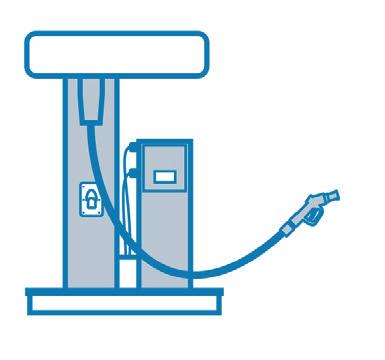
As hydrogen can leak through the tiniest of openings, it is important to ensure that gas seals are leak-tight. In fact, this is one of the most important performance criterion in a hydrogen fuel cell fitting. After all, hydrogen is a small-molecule gas that can leak through the smallest gaps and embed itself into the materials of the fluid system used to contain it.
The method of sealing traditional tube connections along a single line of contact on a narrow surface may work for most liquids and some gases, but hydrogen requires a different method. Its unforgiving nature can degrade the seals once in operation, and the vibration that occurs under regular vehicle operating conditions will challenge the integrity of a single-line seal.

In hydrogen fuel cells, it is advisable to design the gas seals with two lines of contact across longer sealing surfaces – one along the tube, and another along the fitting. The contact surfaces should be placed at slight angles to offer the proper
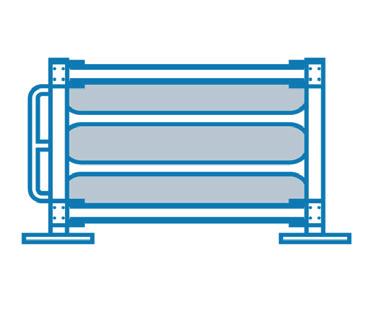
stress level in order to maintain the seal tightness for the duration of its service life. In some cases, it is possible to use two ferrule tube fittings to achieve long-lasting seal integrity.

Another key performance criterion is the fitting’s grip strength. Having sufficient grip strength means that the fitting will stand up to the high pressures that are necessary for refuelling, as well as the vibration that occurs when a vehicle is in motion. The ideal design for a hydrogen fitting is a collected mechanical grip that uses two ferrules (see Figure 3).

A hardened front ferrule can enable the fitting to physically bite into the tubing, creating a very high pressure rating. Meanwhile, a specific back ferrule design allows for a slight amount of movement in the fitting (called ‘spring back’) while maintaining grip and force. This type of design creates robust vibration resistance, ideal for both on-vehicle operation and use on refuelling infrastructure, where compressors and dynamic conditions can create significant vibration.
A mechanical, two-ferrule design that allows for spring back also helps fittings withstand dramatic thermal changes that can cause materials to grow or shrink. During refuelling, hydrogen gas temperatures may vary from as low as -50°C to ambient temperatures, causing issues in conventional cone and thread fitting performance.

Not only will a proper fitting design provide reliable in-use performance, but it makes assembly and installation much easier. OEMs and hydrogen infrastructure developers, whose job it is to ensure a robust future for hydrogen fuel cell vehicles, are looking for these installation and assembly efficiencies.
Traditional cone and thread fittings (see Figure 4) are not designed for easy installation. They require high levels of installer training and specialised tools that may not be readily-available, and take five times longer to install and test than more modern fitting designs (see Figure 5).
Ideally, mechanical grip fittings would come with pre-assembled cartridges (see Figure 6), reducing the complexity of installation. Installers can achieve rapid, error-proof assembly with common tools and minimal training. Suppliers who can provide innovative designs that allow for easy installation have the upper hand in the market.
In situations where reliable performance is paramount, it is critical to proactively resist tube fitting corrosion. Corrosion happens when fluids oxidise metal atoms, which leads to a loss of material on the metal surface. The accompanying thinning of the component wall will make it more prone to mechanical failure, which cannot happen in hydrogen mobility applications. Vehicles and refuelling pumps are often exposed to adverse weather conditions, and the components that make up these systems must be able to resist corrosion over their entire life cycle.
Additionally, hydrogen molecules can be absorbed on the surface of stainless steel, and the individual atoms can be split apart. They have a very small diameter and can diffuse into the
austenitic crystal lattice formed by the much larger iron, nickel, chromium and molybdenum atoms. Diffusion into 316/316L stainless steel occurs very slowly, but at high pressures and over long periods of time, significant amounts of hydrogen atoms can accumulate in the lattice. In lower-quality stainless steels, this diffusion can lead to a breakdown of the material, resulting in a
Figure 3. The two ferrules in this fitting design provide a colleting action that securely grips the tube. The hardened front ferrule (dark grey) enables the fitting to physically bite into the tubing. The back ferrule (light grey) allows for a slight amount of movement in the fitting, while maintaining grip and force.
Figure 4. Traditional cone and thread fittings are not designed for ease of installation.
Figure 5. Traditional cone and thread fittings take five times longer to install and test than more modern fitting designs.
loss of ductility. This is known as hydrogen embrittlement. Even when present at large concentrations, hydrogen atoms do not tend to negatively affect the strength of 316/316L. However, should fatigue cracks be present, hydrogen atoms would make it easier for these cracks to propagate through a component. Lower-performing alloys may be more susceptible to this issue over the long-term.
Higher concentrations of chromium and nickel in fluid system components can help defend against common corrosion and hydrogen embrittlement, by retaining greater ductility. The American Society for Testing and Materials (ASTM) requires a minimum of 10% nickel in 316 stainless steel. However, it has




been shown that higher-quality 316 stainless steel with 12% minimum nickel is better suited to the unique challenges of hydrogen.
While there are a variety of compression tube fittings and other styles that may be applicable to hydrogen fuel systems, very few are designed to satisfy the many unique performance demands that hydrogen applications require.
There are, however, exceptions. Operators should look for designs that have EC-79 and European Integrated Hydrogen Project (EIHP) certifications, and pressure ratings of up to 1050 bar. It is also important to use fittings that are made of 316 stainless steel with 12% minimum nickel content. With these specifications, the fittings will meet the rigorous standards necessary for today and tomorrow’s hydrogen fuel cell infrastructure.


Hydrogen has the potential to reshape the mobility economy as we know it. As sustainability continues to grow as a global priority, hydrogen is the most viable energy solution that is available for transportation use. The keys to its continued adoption are safe, reliable hydrogen vehicle and refuelling systems that OEMs and other stakeholders can rely on now, and depend upon for years to come.
The long-term viability of hydrogen mobility will depend on safe, reliable and durable hydrogen vehicles and infrastructure. Selecting and specifying the right components for critical systems can help achieve these goals.

As engineers worldwide focus intently on hydrogen, there is an awareness that it is one of the universe’s smallest molecules, and that it diffuses readily through materials as a result – including the base-metal substrates and coatings of the valves that are critical to safe hydrogen processing. A lot of thought is also going into how to filter and dry hydrogen so that it can be transported and stored safely.

The safety issues associated with hydrogen have been raised as its potential downfall when used widely. It is therefore important that strong safety measures are taken. However, some of its properties mean that it could in fact be safer than other fuels, such as gasoline and diesel. 1
Gaseous hydrogen, when mixed with omnipresent oxygen in the air, can self-ignite (although liquid hydrogen is far less volatile). As such, the hydrogen infrastructure of the future will need to use both isolation and control valves to ensure that hydrogen continues to flow safely.
Zero-leakage isolation valves will be required for the prevention of leaks, both externally and internally – from the valve stem or body/bonnet joints, as well as through the ball and seat. Control valves must operate with precision, preventing external leakage. Filters and dryers, built for longevity, will help to safely transport and store hydrogen.
Fugitive emissions from quarter-turn valves are governed by the API 641 standard, released in late 2016. As with the earlier standard (API 624 for rising-stem valves), API 641 is the type test for quarter-turn valves, addressing their low-emission performance during an accelerated life cycle.
The new standard applies to all stem-seal materials. To pass API 641, the valve must not allow leakage of more than 100 ppmv for the test’s duration. The standard requires 610 cycles of the valve under extreme, fluctuating temperatures, thereby evaluating emission performance during an accelerated life cycle.
‘Through’ leakage, between the valve’s ball and seat, is addressed by the most stringent ANSI standard: Class VI, for hydrogen service. External leakage, from a body or stem joint leaking to the atmosphere, is addressed by ISO 15848-1. Meeting the standard, at the highest level (AH), typically requires bellows seals or an equivalent stem (shaft) sealing system for quarter-turn valves. ValvTechnologies achieved class AH by using bellows seals rather than fugitive emissions packing.

To process high-purity silicon for a US manufacturer of semiconductors, ValvTechnologies developed its V Series with RiTech® H zero-leakage valves for helium service. The semiconductor manufacturer successfully used nearly 5000 of the zero-leakage valves from 2004 to 2015, when it was compelled to close due to global trade restrictions.

Increasingly, this valve is chosen for select hydrocarbon processes, using either pure or partial hydrogen, at multiple refineries worldwide. In addition to this, it is well suited to the emerging hydrogen market.
To ensure zero hydrogen leakage, these valves (both balls and seats) are coated with a proprietary chemical solution and compressive spray technique that fills and seals the inherent microcracks and porosity of their base metals.
This process is called RiTech, which is short for Robotically Integrated Technology.
Valve components, whether chromium or tungsten carbide, are saturated with the chemical solution at room temperature. They are then fired, chemically bonding the coating and substrate. The firing takes place in a robotically-integrated, high-velocity, oxygen-fuelled spray booth. This process reduces porosity to zero, preventing even the most minor infiltration by hydrogen molecules or corrosives.
The chemical coating is optimum for both impure hydrogen and for pure hydrogen at pressures of less than 3500 psi/241 bar. If pressures exceed this, a spray-and-fuse technique must then be used.
To completely eliminate leakage, an integral seat excludes the possibility of gas escaping between a separate seat and seat pocket. A Belleville spring forces the upstream seat into the ball and, in turn, into the integral seat. The spring load is very high, guaranteeing that hydrogen cannot leak past the seat. With such tight isolation, the valves produce higher operating torques.
Isolation and control valves play different roles: control valves regulate fluid flow by adjusting their flow area, as signalled by a controller, to manipulate pressure, temperature and liquid level. Globe control valves with rising stems use live-loaded, high-integrity gland packing, or even a bellows seal, to precisely control external leakage. These valves typically meet both international and ASME standards.
When selecting a control valve, it is important to look for multiple trim options that will enable the valve to meet future requirements. As hydrogen demand increases, these valves can be retrofitted for precise control.

As with compressed air and other industrial gases, hydrogen must be carefully filtered and dried before it can be safely transported or stored. Although the world’s hydrogen infrastructure is still at the conceptual and FEED stages, the technology to filter and dry hydrogen is well proven.
A special concern is hydrogen’s tendency to embrittle metal. However, the use of high-quality raw materials, such as specialised stainless and carbon steels, eliminates that problem. Custom-designed filter and dryer assemblies are manufactured to meet very specific longevity and safety requirements.
“It is important to work closely with customers to define their requirements and develop custom solutions” said Mark Green, Field Sales Manager at LB Bentley Ltd, and co-author of this article. “Highly-engineered services are far from ‘off the shelf,’ and the hydrogen industry should support those required engineering hours.”
He adds: “Hydrogen technology is developing quickly. Our job is to support our customers by offering them well-thought-out solutions throughout their project’s
Figure 3. Hydrogen filter and dryer assembly.
life cycle. It is the only way to fully support the energy transition. Customer/supplier partnerships are crucial to adequately engineer these tough applications.”
High-pressure LB Bentley filter and dryer products are already supplied to UK customers and have been operating reliably for more than 20 years, scrubbing and purifying hydrogen to 750 m 3 /hr at 250 bar working pressure.

Isolation and control valves, as well as custom-designed filters and dryers, will play a crucial role in the world’s hydrogen future – safely treating, containing and controlling hydrogen in both liquid and gaseous form.
ValvTechnologies, Severn and LB Bentley will continue to develop and refine their products to meet the most exacting performance and safety standards, both during and after the energy transition.
1. TAE, C., ‘Hydrogen Safety: Let’s Clear the Air’, NRDC, (14 January 2021), https://www.nrdc.org/experts/christian-tae/ hydrogen-safety-lets-clear-air

There are several purposes for measuring the calorific value (CV) of natural gas. These include determining the transaction value of natural gas; quality control based on heating value standards for the injection of hydrogen; controlling plant combustion equipment for stable operation; and controlling air to fuel ratios for gas turbine generators that require precise combustion control. High measurement accuracy, continuous measurement, and fast response are requirements for CV measurement, but the emphasis on each requirement will vary according to the purpose of the measurement. Among the most trusted natural gas calorimeters providing high measurement accuracy are gas chromatograph (GC) calorimeters.
The principle of gas chromatography involves the separation of the test gas into its components and quantifying the amount of each component. The CV is then calculated based on these amounts. The measurement accuracy of a GC calorimeter is determined by the gas separation performance and quantification accuracy. However, most

natural gas GC calorimeters were not designed to anticipate hydrogen blending. As such, these instruments are incapable of separating and quantifying the hydrogen component and therefore cannot measure the CV of hydrogen-blended natural gases.
Although there are GCs capable of separating the hydrogen component, the operational principle of gas chromatography – i.e. sampling the test gas, component separation, quantification and CV calculation – does not lend this method to controlling applications that require fast response and continuous measurement.
Another widely-adopted instrument is the combustion calorimeter, which is known for its continuous measurement capability. Combustion calorimetry involves the measurement of the heat generated or the concentration of the oxygen after it has been consumed during combustion.
Even if hydrogen is blended into natural gas, this would not pose a problem for measuring the CV, as long as the air ratio
could be adjusted to encourage combustion. However, because the detection principle is based on a combustion reaction, achieving high accuracy is a challenge.
This article introduces the Riken Keiki Opt-Sonic method that utilises the speed of light and sound in gas mediums to resolve the CV of a hydrogen-blended gas (hydrogen and natural gas/methanation, etc), and for continuous measurement of the gas compression factor.
The Opt-Sonic method measures the speed of light in the fuel gas and the speed of sound to calculate the CV. This method is capable of measuring the CV with high accuracy, continuously, and with fast response times.
The principle for the method is explained in Figure 1. Image (A) in Figure 1 shows the relationship between the refractive index of a medium and its CV for several gases. The refractive index is the ratio of the speed of light in vacuum to the speed of light in a specific medium.
The function QOPT – the straight line in image (A) in Figure 1 formed by the square data points – depicts the relationship between refractive indices and CVs of gas mixtures comprising paraffinic hydrocarbon gases and hydrogen.
Figure 1. Opt-Sonic calculation.
Test gas H2 N2 CO2 CH4 C2H6
CH4 100.000
NG-1 10.000 88.003 1.997
NG-2 4.000 94.402 1.598 NG-3 6.667 92.002 1.331 NG-4 98.003 1.997 NG-5 7.500 2.500 90.000 NG-6 5.000 2.500 87.008 5.492 NG-7 93.343 6.657
CH4+N2 10% 10.000 90.000
CH4+N2 20% 20.000 80.000
CH4+N2 30% 30.000 70.000
CH4+N2 40% 40.000 60.000
CH4+CO2 10% 10.000 90.000
CH4+H2 2.5% 2.500 97.500
CH4+H2 5.0% 5.000 95.000
CH4+H2 7.5% 7.500 92.500
CH4+H2 10% 10.000 90.000
CH4+H2 15% 15.000 85.000
CH4+H2 20% 20.000 80.000
NG+H2-1 10.000 10.000 80.000
NG+H2-2 20.000 5.000 75.000
NG+H2-3 10.000 5.000 80.008 4.992
NG+H2-4 20.000 5.000 71.006 3.994
NG+H2-5 10.000 88.003 1.997
NG+H2-6 20.000 76.006 3.994
Image (B) in Figure 1 shows the relationship between the speed of sound in the medium and its CV. The function QSONIC – the straight line in image (B) in Figure 1 – describes the relationship between the speeds of sound in hydrogen and paraffinic hydrocarbon gas mixtures and their CVs.
If the fuel gas comprises only paraffinic hydrocarbons and hydrogen, the CV can be obtained from the functions QOPT or QSONIC. However, errors are introduced to the functions if the fuel gas (i.e. natural gas) includes miscellaneous gases such as nitrogen (N2), carbon dioxide (CO2), oxygen (O2) and carbon monoxide (CO). These gases are indicated with solid triangles in image (A) and image (B) in Figure 1, and do not align with the linear functions QOPT and QSONIC
The CV Q for gas mixtures containing the miscellaneous gases may be expressed by equations 1 and 2:
Q = QOPT – (kN2XN2 + kO2XO2 + kCO2XCO2 + kCOXCO) (1)
Q = QSONIC – (k’N2XN2 + k’O2XO2 + k’CO2XCO2 + k’COXCO) (2)
Where Xi (i = N2, O2, CO2 or CO) represents the volume fraction of gas component i, and k i and k’ i represent the error coefficients of gas component i. The latter error coefficients are shown as vertical dashed lines in image (A) and image (B) in Figure 1.

Although k i and k’ i have different values, the ratio between the two remains approximately constant, regardless of composition, as expressed in equation 3:
k’N2 = αkN2, k’O2 ≈ αkO2, k’CO2 ≈ αkCO2, k’CO ≈ αkCO (3)
Using equation 3, equation 2 can be transformed into equation 4:
Q ≈ QOPT - (QOPT - QSONIC) / (1 - α) (4)
Image (C) in Figure 1 shows the relationship between the calculated results from equation 4 and the actual CV of each gas. Every gas data point is on or near the straight line, which has a slope of 1.


A test with simulated hydrogen-blended natural gas was performed with standard gas cylinders. A number of test gases were prepared (shown in Table 1) based on the following information:
� Methane (CH4): 90 – 98%.
� Ethane: 0.5 – 2% (for LNG applications up to 6%).
� Propane: below 0.3%.
� Butane+: below 0.2%.
� N2: up to 10%.
� CO2: below 3%.
(mixtures of CH 4 + H 2)
� Hydrogen – concentration below 10%.
� Composition approximately 60% CH4/40% N2
According to a study by French gas transmission system operators, future downstream equipment will be adapted for hydrogen, and the hydrogen blending percentage will go up to 10%, eventually rising to 20%. The 20% threshold seems to be the upper limit, above which significant investments will be required, particularly for downstream uses. In addition to this, there is a project in the UK whereby the hydrogen blending percentage will rise to 20 vol%. As such, the hydrogen contained in the test gases is maximum 20 vol%.
Figure 2 shows the evaluation results. The theoretical CVs (calculated based on the composition) were compared with the measurement results from the Opt-Sonic method.
As shown in Figure 2, the measurement accuracy is within ± 0.5%, which is compliant to R140, CVDD Class A of the International Organization of Legal Metrology. Internal testing at Riken Keiki has shown that accuracy within ± 0.5% can be achieved for hydrogen concentrations of 0 – 20 vol%.
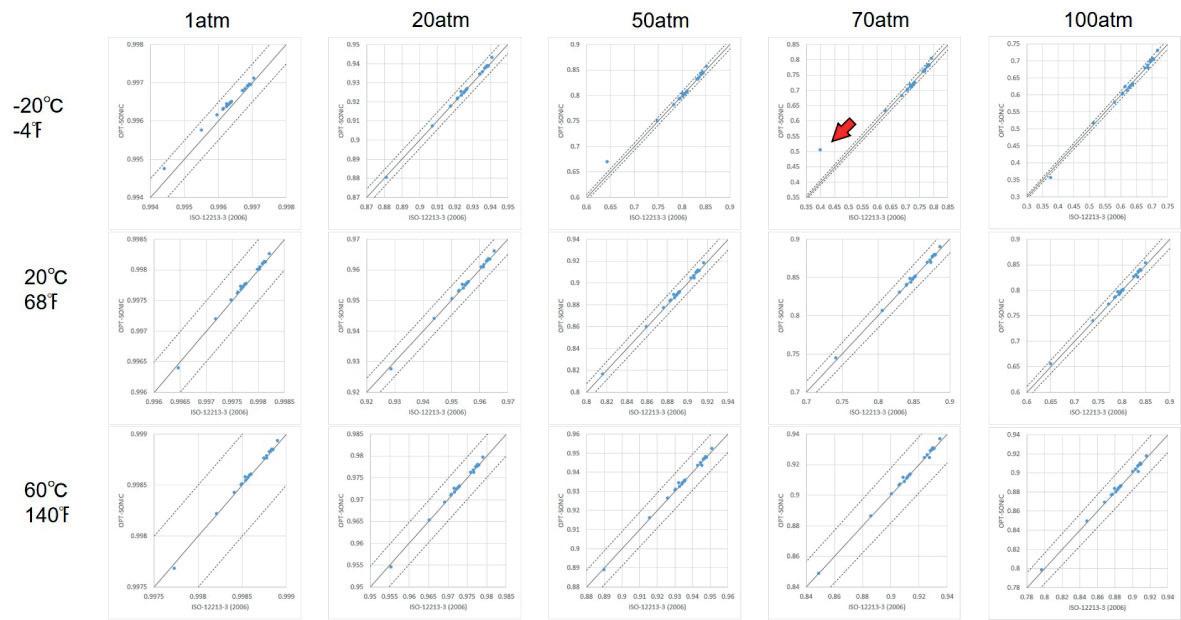
During methanation, the concentration of CH4 , CO2 and H 2 requires monitoring to assess the quality of the process. The Opt-Sonic method can calculate the volume of CH4 , CO 2 and H 2 , in addition to the CV of the mixed gas. The measuring range for CH4 is 70 – 100%, CO2 is 0 – 30%, and H 2 is 0 – 20%.
Table 2 shows the evaluation result. Five standard cylinders with simulated methanation gas were measured. The theoretical CVs calculated based on ISO6976 were compared with the measurement results from the Opt-Sonic method.
As shown in Table 2, the Opt-Sonic measurement result is close to the theoretical CVs and the concentrations. This method performed by OHC-800 can be an all-in-one solution to help the stabilisation of methanation.
The Opt-Sonic method can also continuously calculate the gas compression factor. The compression factor is usually calculated using the CV, specific gravity, and volume of CO2 However, this new method establishes a means to continuously calculate the compression factor from the CV and specific gravity.
Figure 3 shows the test results in the company’s laboratory, under various conditions, assuming some natural gas composition that is mentioned in ISO TR 22302 2014, Table B.6. The temperature is fluctuating from -20 to 60˚C and the pressure is fluctuating from 1 to 100 atm. The results are closer to the compression factor calculated by ISO12213-3.
The result indicated by the red arrow is the result with the test gas containing iso-butane approximately 6 vol%, and iso-butane is liquefied under
low-temperature and high-pressure conditions. This is why the result is set apart from the straight line. However, natural gas contains a high volume of iso-butane in very few cases.
Figure 4 shows the field test result from a gas company. 0.83 – 1.37 vol% of N 2 and 0.72 – 0.94 vol% of CO2 are contained in the natural gas. The temperature is fluctuating from 19.2 to 40.6˚C and the pressure is from 73 to 97 atm. The total number of GCs counted was approximately 1500. Compared to the ISO12213-2, the average was +0.062 and the standard deviation was 0.027%.
According to these results, it can be assumed that this new calculation method for continuous measurement of the gas compression factor will allow for the performance of more advanced feedforward control gas turbines.
The adoption of environmentally-sustainable energy sources such as solar power and wind generation will continue to grow. As a result, power-to-gas technology will become increasingly indispensable as a solution for moderating the weather-induced fluctuations in energy production.
The calorimetry technology demonstrated by the Opt-Sonic method is capable of measuring hydrogen-blended gas with high accuracy, continuously, and with fast response times, and is ideally positioned to provide a solution that will facilitate the efficient use of new resources synthesised from renewable energy.

Figure 4. Field test result: average deviation of compression factor.
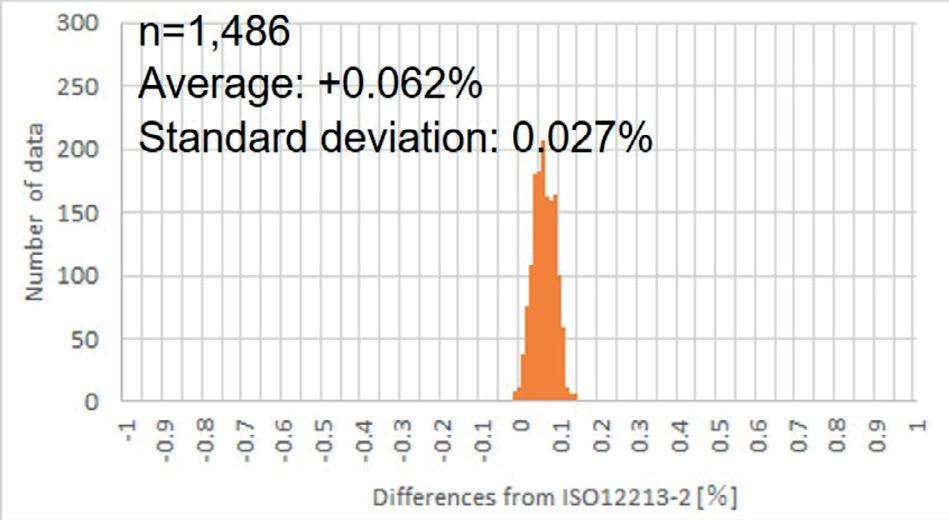
Composition ISO 6976 Actual OHC-800 measuring value* CH4 H2 CO2 Calorific value CH4 H2 CO2 Calorific value (vol%) (MJ/m3) (vol%) (MJ/m3)
Case 1 96 4 0 38.85 95.8 4.2 0 38.80
Case 2 87.5 10 2.5 36.21 87.4 10.2 2.4 36.22
Case 3 80 0 20 31.94 79.9 0.1 20 31.93
1:0:0 100 0 0 39.94 100 0 0 39.94
3:1:0 75 25 0 33.13 74.9 25.1 0 33.12
* 1 digit: 0.1 (vol%) 0.01 (MJ/m3)

Wärtsilä has entered into a joint development agreement (JDA) with Hycamite TCD Technologies, a privately-owned Finnish company specialising in the development of technology for producing clean hydrogen and solid carbon from methane.
The two companies will work together to enable the cost-effective production of hydrogen from LNG onboard marine vessels. The concept design will be ready by mid-2023, and the prototype testing unit will be ready during 2H24.
The concept will allow the existing LNG infrastructure to be utilised, and enable production of hydrogen onboard in combination with Wärtsilä’s LNGPac Fuel Gas Supply System. By producing hydrogen onboard and blending it with LNG, the current range of fuel-flexible Wärtsilä dual-fuel (DF) engines can reduce the vessel’s overall carbon dioxide (CO2 ) and methane slip emissions. Alternatively, the hydrogen can also be used in fuel cells onboard.
Tree Energy Solutions (TES), a world-scale green hydrogen company with a mission to deliver a net zero future by decarbonising the energy chain, and EWE, one of Germany’s largest integrated utilities, have announced the signing of a Memorandum of Understanding (MoU) to build an electrolyser in TES’ green energy hub in Wilhelmshaven, Germany.
The electrolyser is to be installed and operated starting in 2028. The planned capacity of the electrolyser is 500 MW, and one more unit is forecast to reach a total capacity of 1 GW. This MoU is in line with Germany’s strategic energy policy to develop clean energy generated by the North Sea and broaden the possible supply for hydrogen. The signing marks a joint interest in delivering national energy security as Germany continues to diversify its energy supply from renewable energy sources.
The hub in Wilhelmshaven is strategically placed on the North Sea coast, and can accommodate up to 2 GW capacity electrolysers with renewable energy sources such as offshore wind in order to generate locally-produced green hydrogen.
I n November 2022, Snam successfully completed a series of tests aimed at experimenting with the use of hydrogen as a fuel to power gas turbines, at one of its natural gas compression stations in Istrana, Italy. The experiment, which was the first of its kind globally and carried out in collaboration with Baker Hughes, demonstrated the compatibility of the various assets with the use of a blend of hydrogen (at 10%) and natural gas.
The Istrana plant is one of 13 compression stations along Italy’s gas transportation network, with the function of boosting gas to help it travel through pipelines towards the various consumption points across the country. This is the first Italian compression station in which a ‘hydrogen-ready’ turbine, the NovaLT12, designed and built by Baker Hughes in its Italian plants, has been installed.
The tests also involved another Baker Hughes turbine which was already in operation in the plant, the PGT25, designed for operation with natural gas, which was tested for the first time using a blend of natural gas and hydrogen.
Meridian, with the support of Ngai Tahu, has selected Woodside Energy (Woodside) as the preferred partner to move forward to the development stage of the proposed Southern Green Hydrogen (SGH) project in New Zealand. A final investment decision (FID) will follow the development stage.
Woodside was selected after an extensive competitive bidding process, based on its capability and experience in operations, process safety, and liquids marketing.
Mitsui is also in discussions to join the project and develop the potential market for ammonia offtake, with the aim of creating a world-class collaboration that covers the full hydrogen and ammonia supply chain. Mitsui has 50 years of experience in the ammonia business, including the largest share of ammonia imports into Japan.
Subject to finalising commercial arrangements, Meridian, Woodside and Mitsui will work towards commencing front-end engineering design (FEED) for the project.
Wärtsilä and Hycamite to develop technology that produces hydrogen from LNG
TES and
to build electrolyser at the Wilhelmshaven
Snam and Baker Hughes trial the use of hydrogen for gas compression
Woodside selected as a partner for Meridian’s SGH project
Hydrocarbon-rich countries have the potential to effectively produce clean hydrogen at scale, repurposing existing infrastructure and supporting global decarbonisation, according to a new McKinsey study.
McKinsey’s new report reveals how hydrocarbon-rich countries can leverage their experience in large energy projects, access to abundant renewable energy, and their extensive, highly-developed export infrastructure in order to facilitate the scaling up of blue and green hydrogen.
HRCs form a diverse group across a range of climates and geographies, including countries such as Canada, the US, and Saudi Arabia. Not only do these countries possess the hydrocarbons necessary to produce low-carbon blue hydrogen, but they also have experience in developing and operating complex industrial projects, and tend to have the renewable resources to produce green hydrogen at scale.
